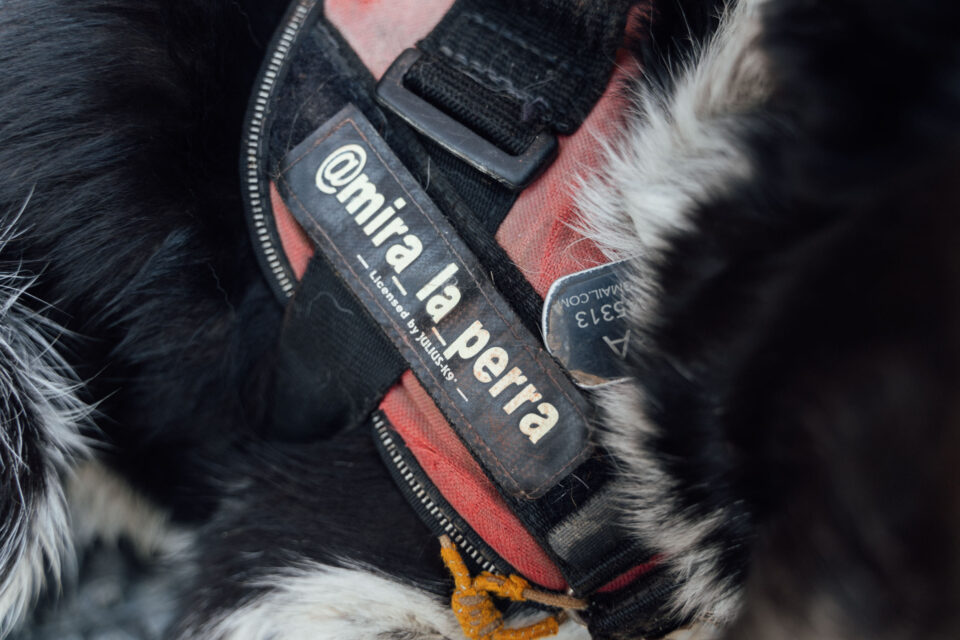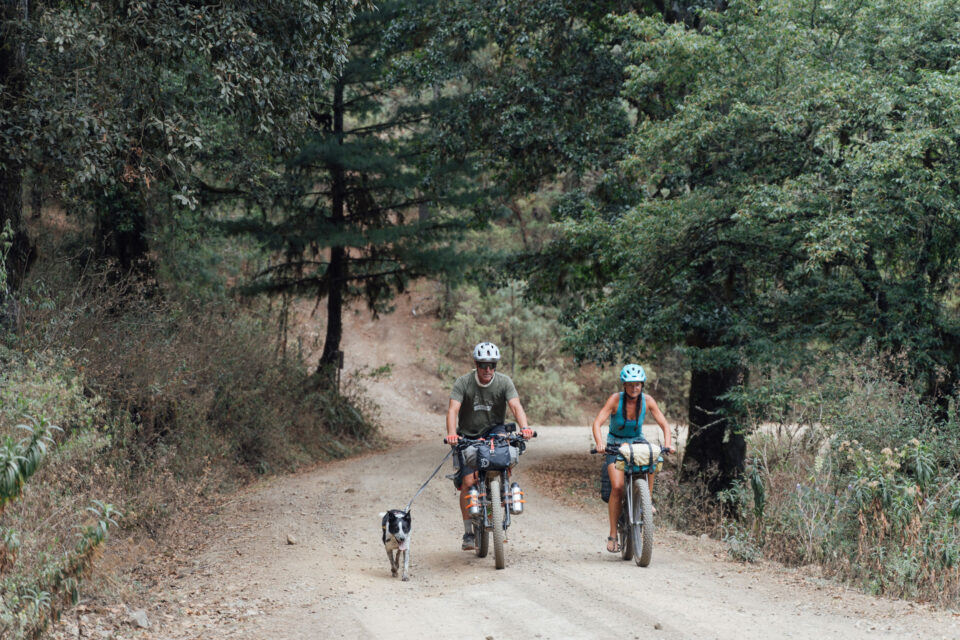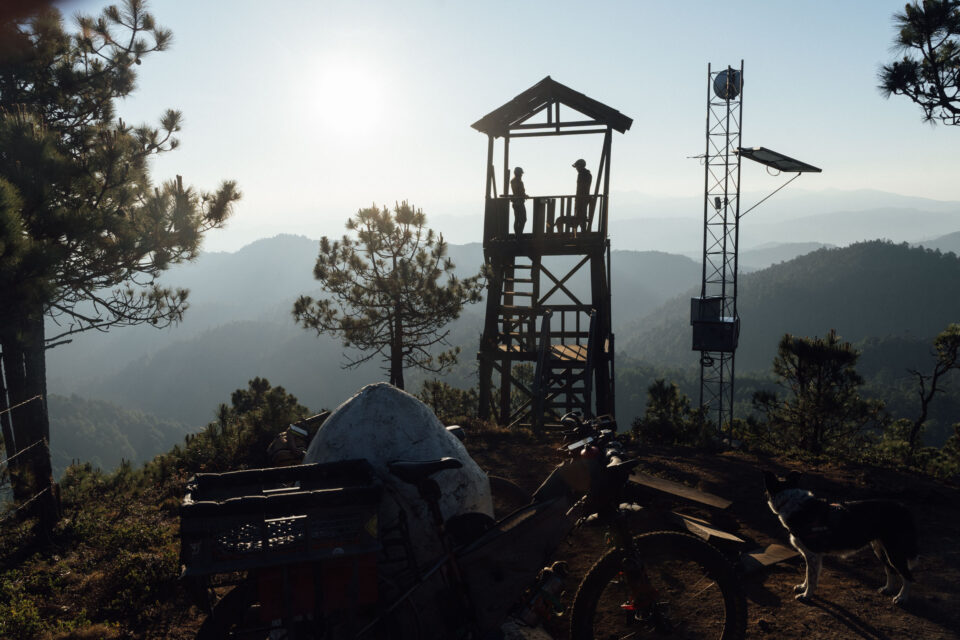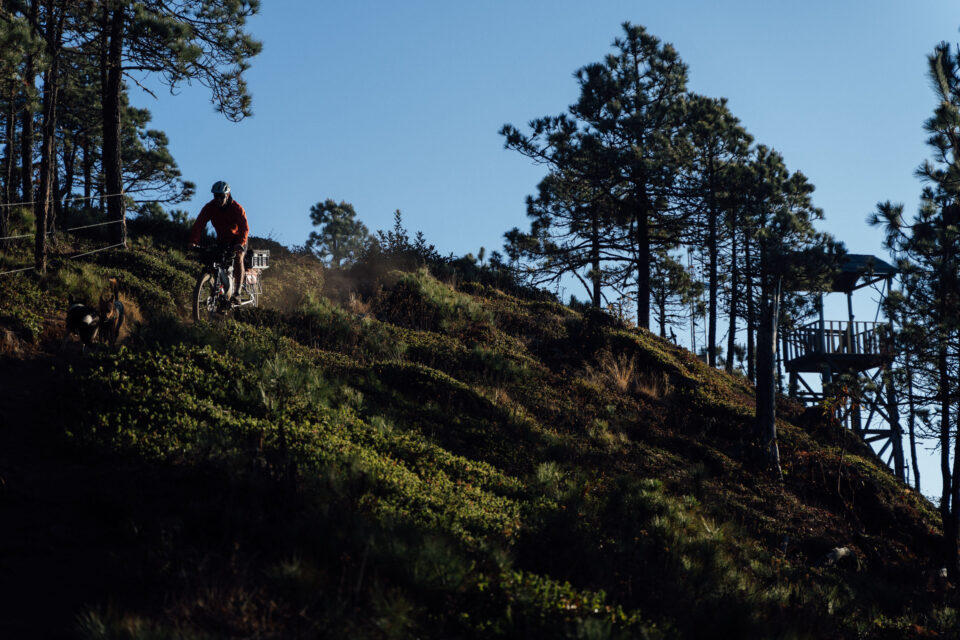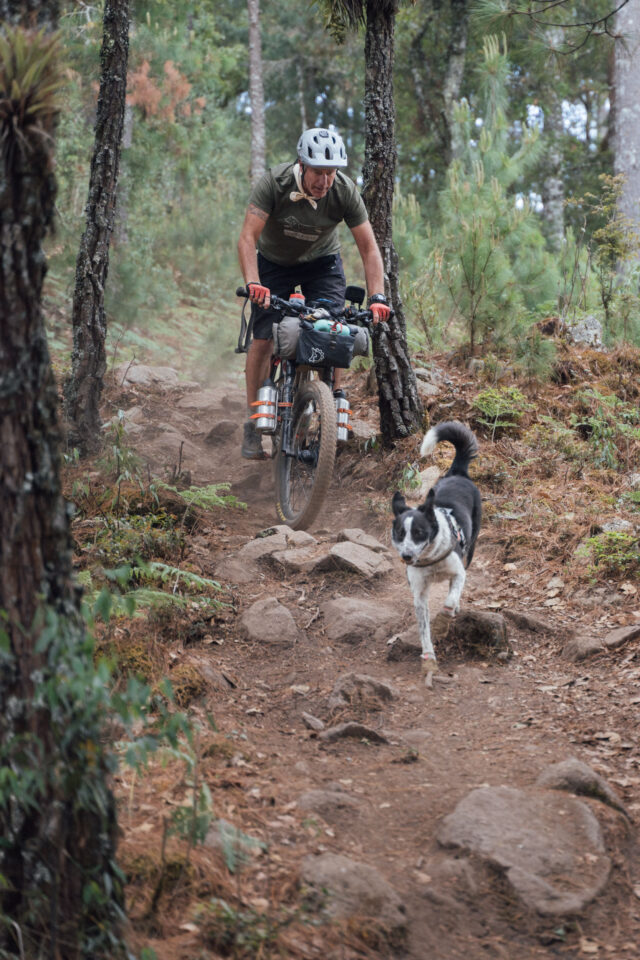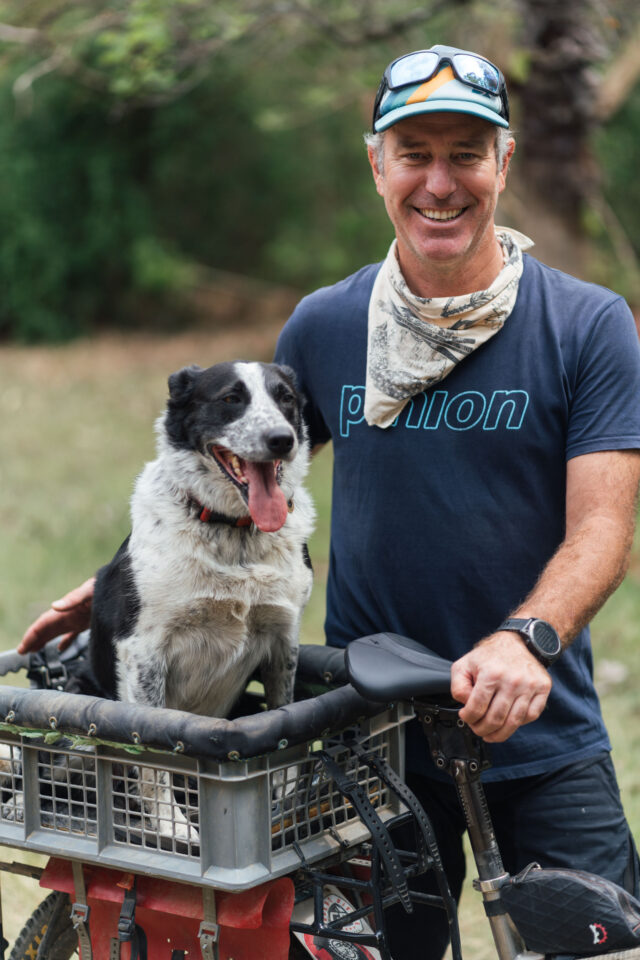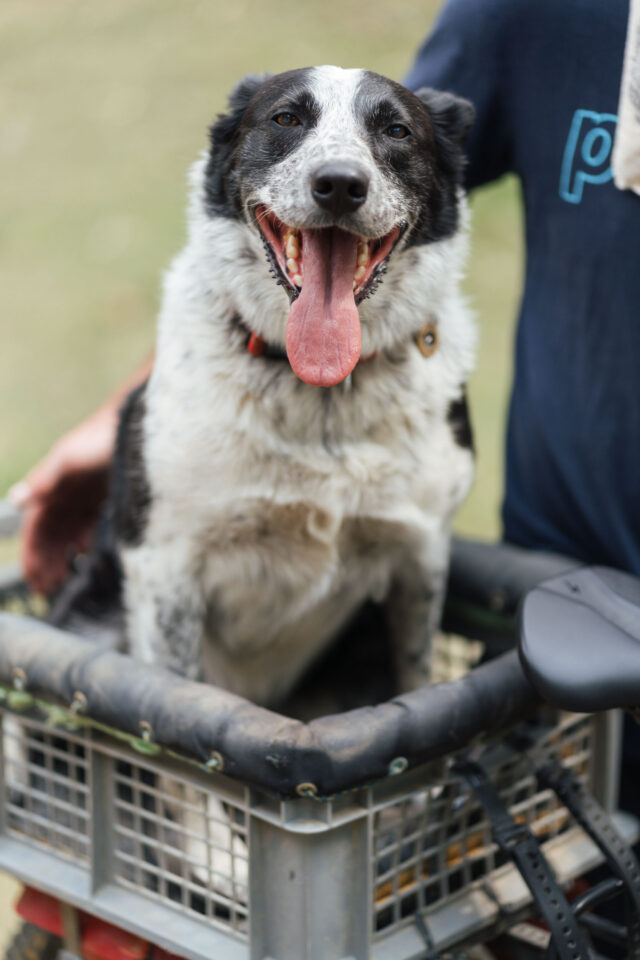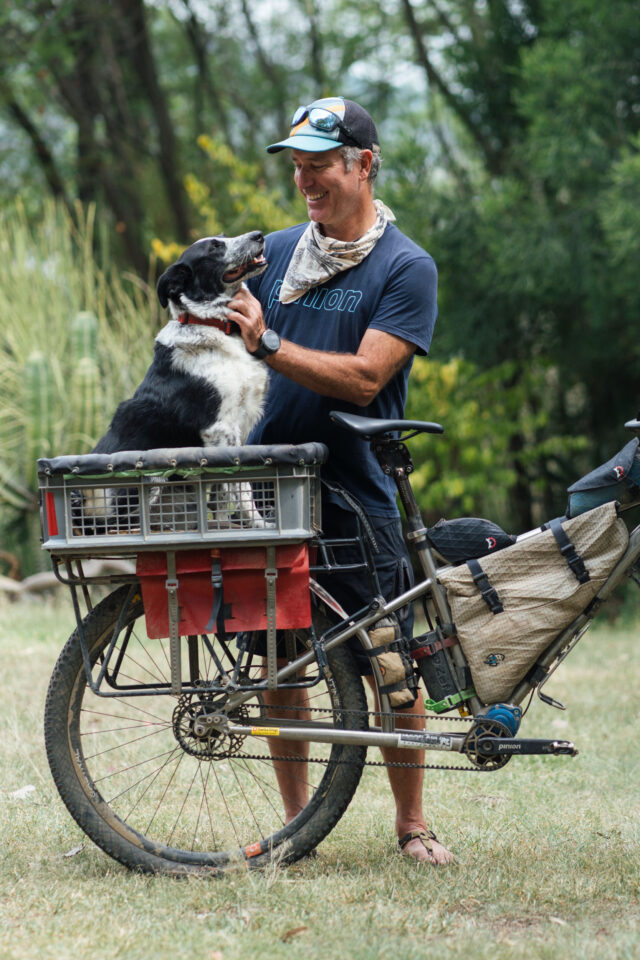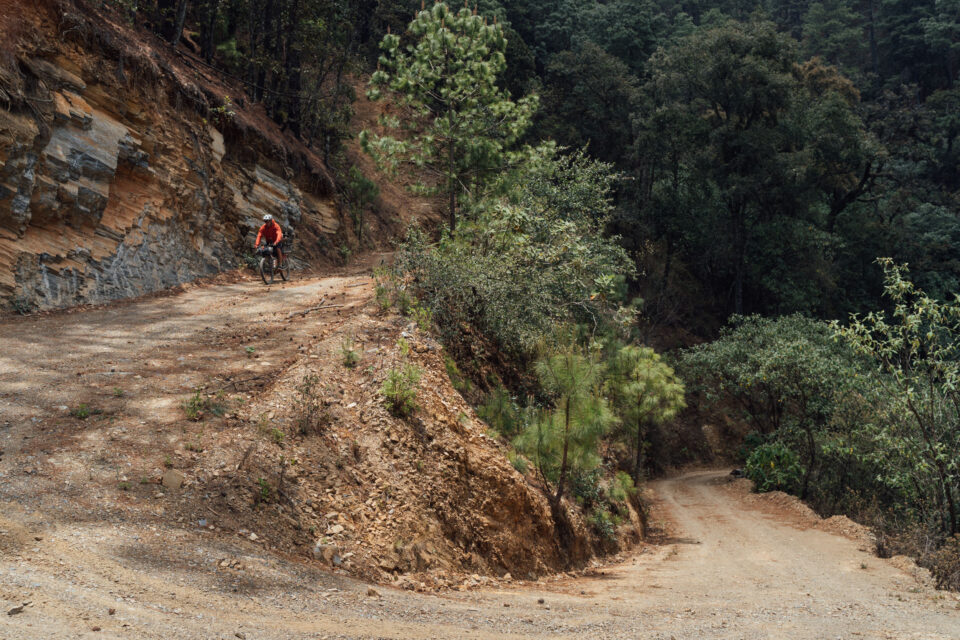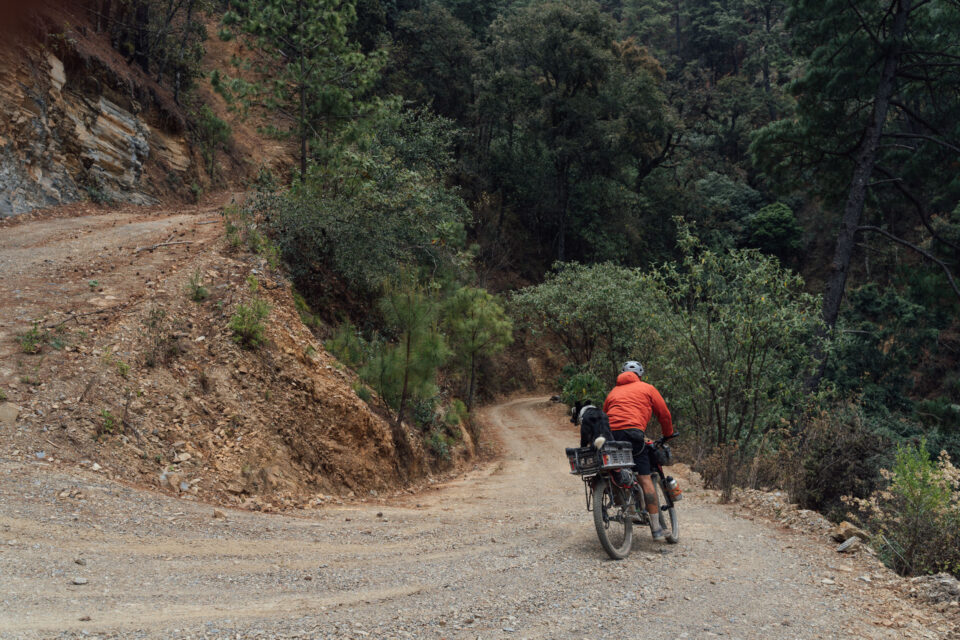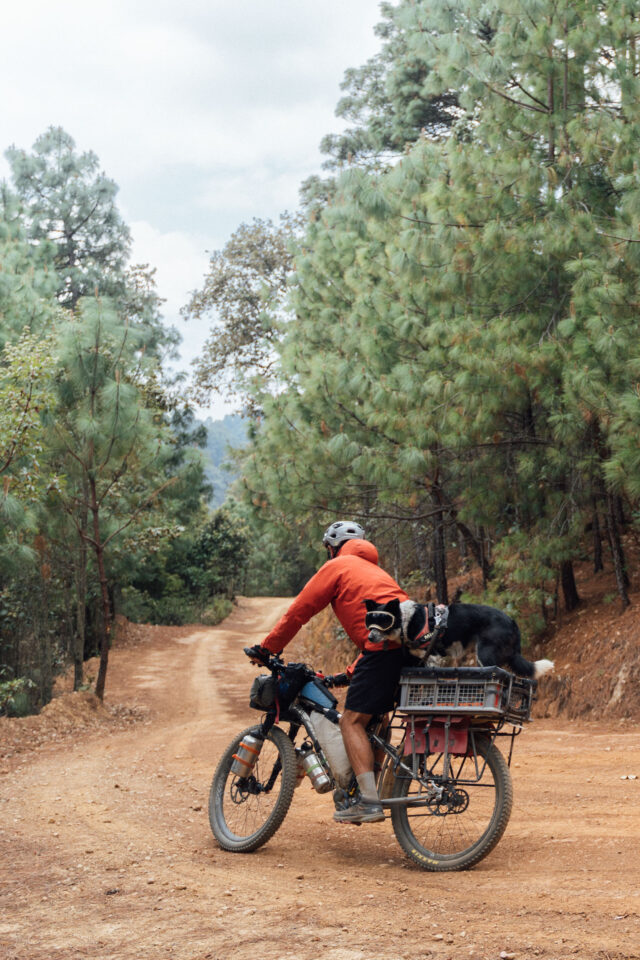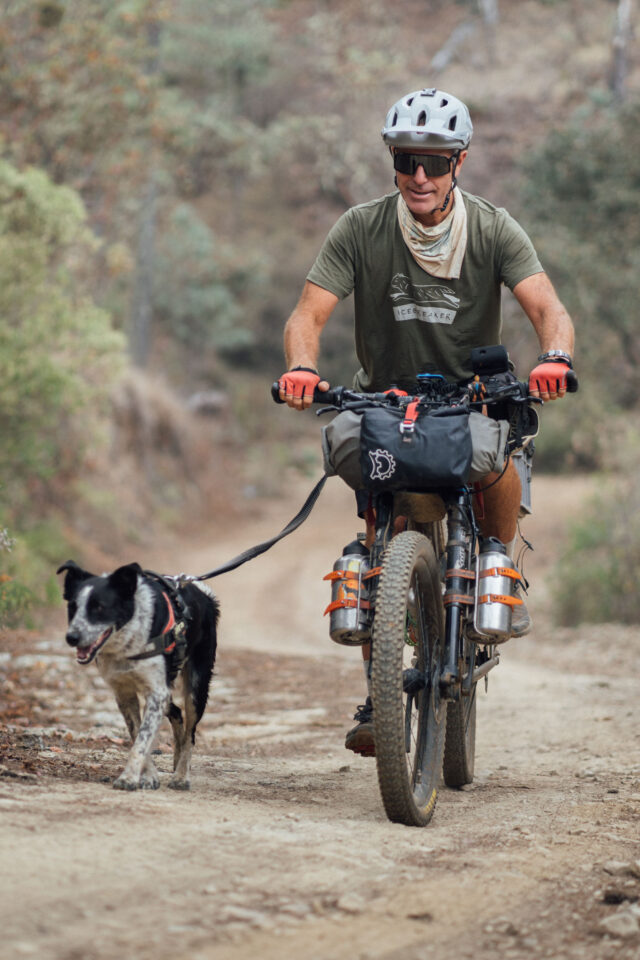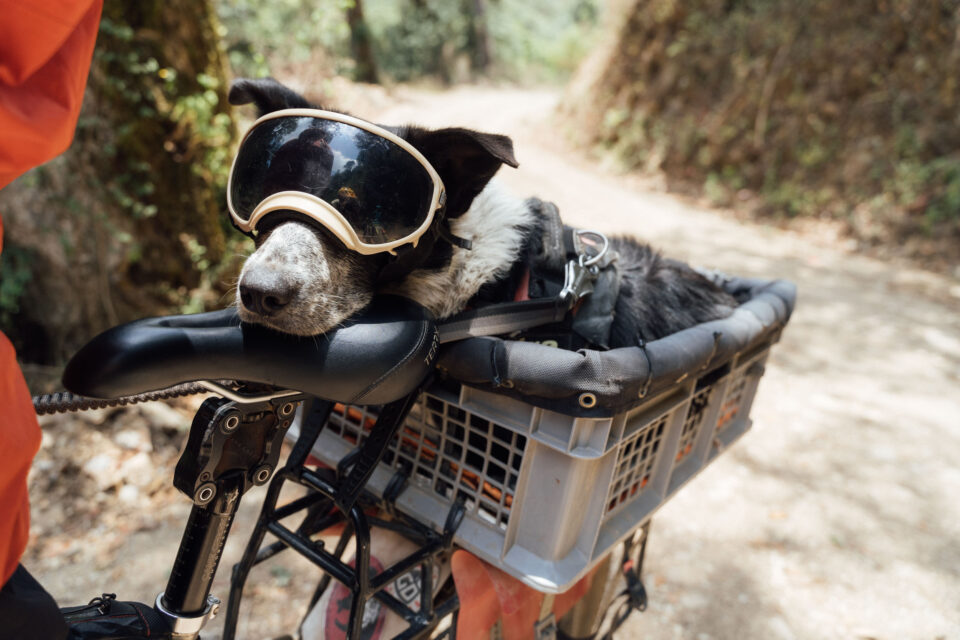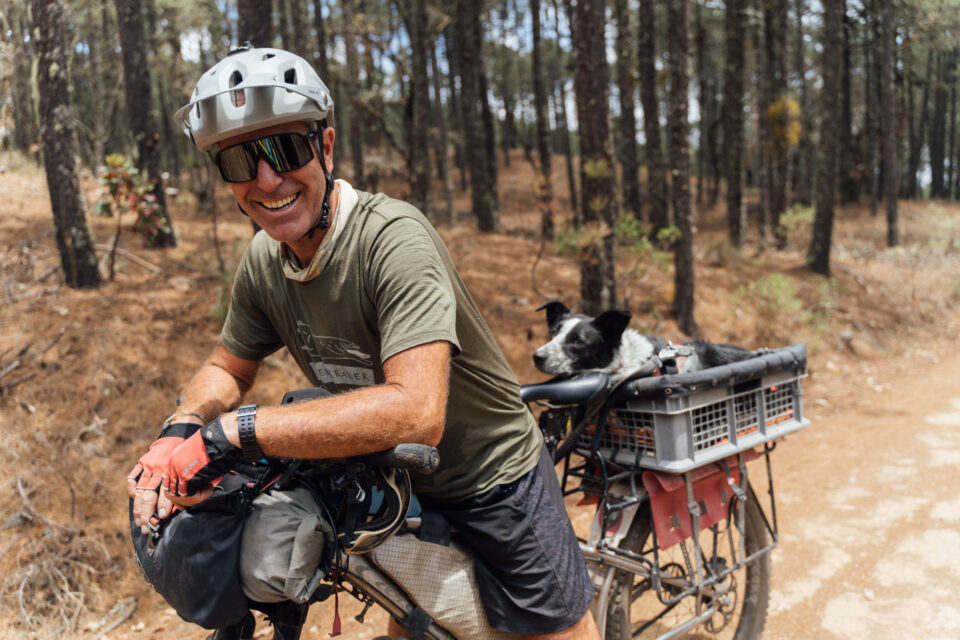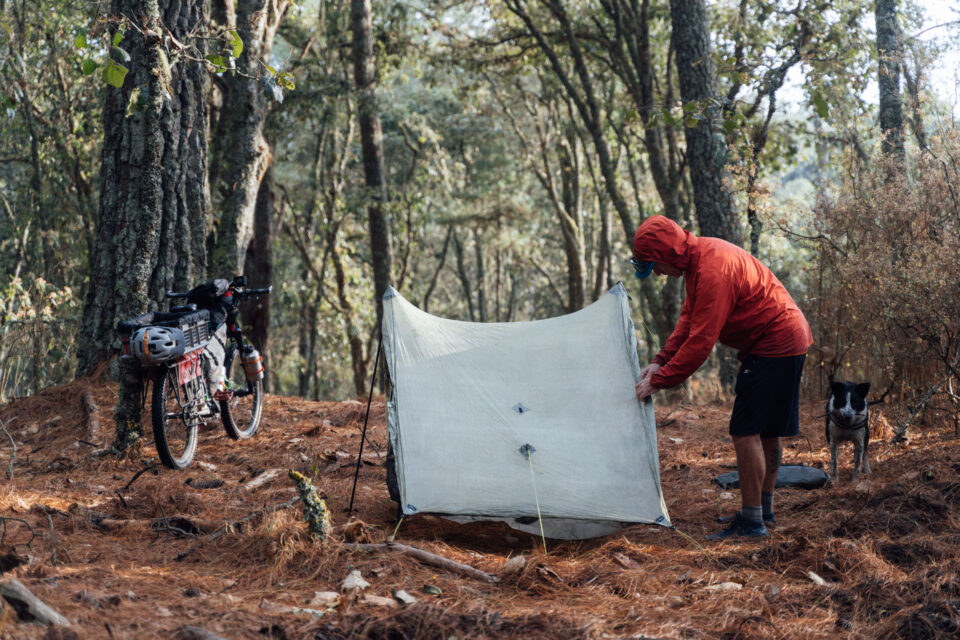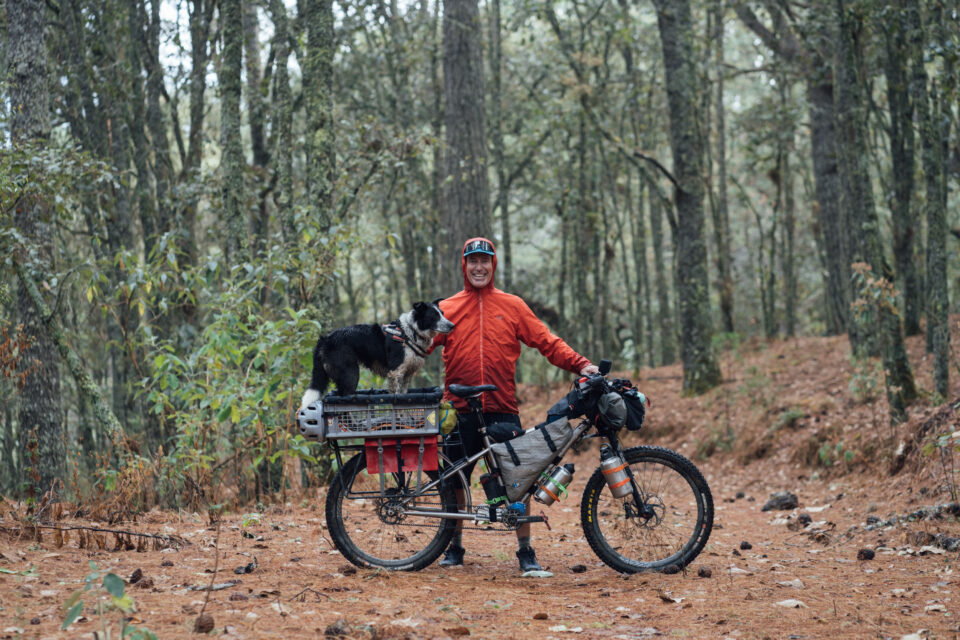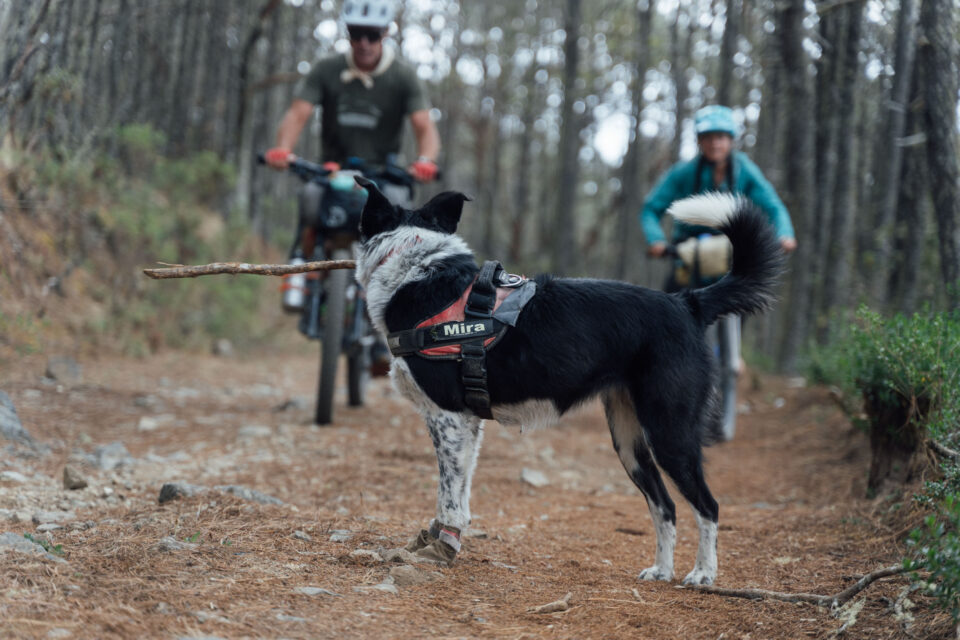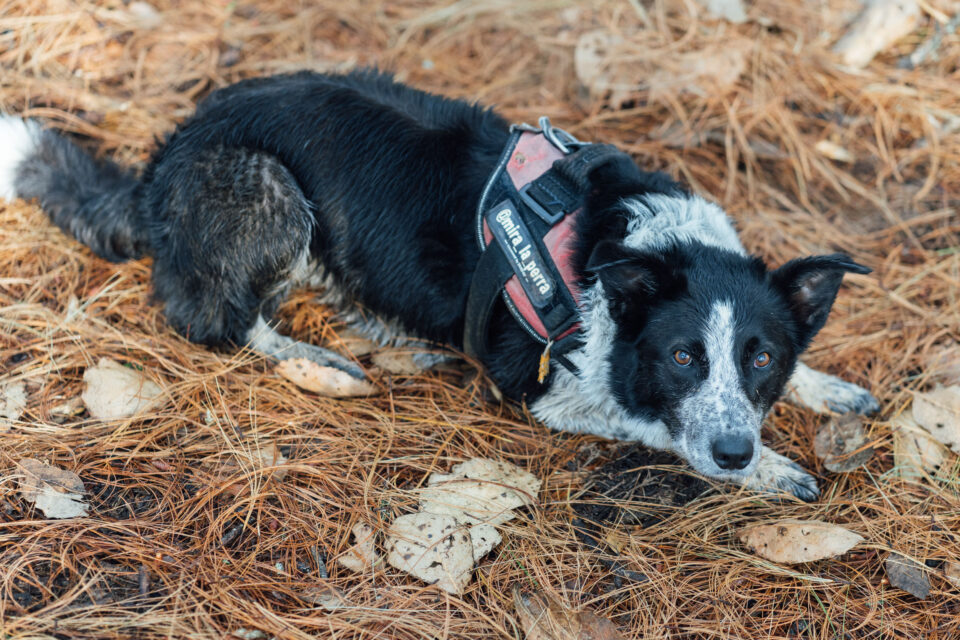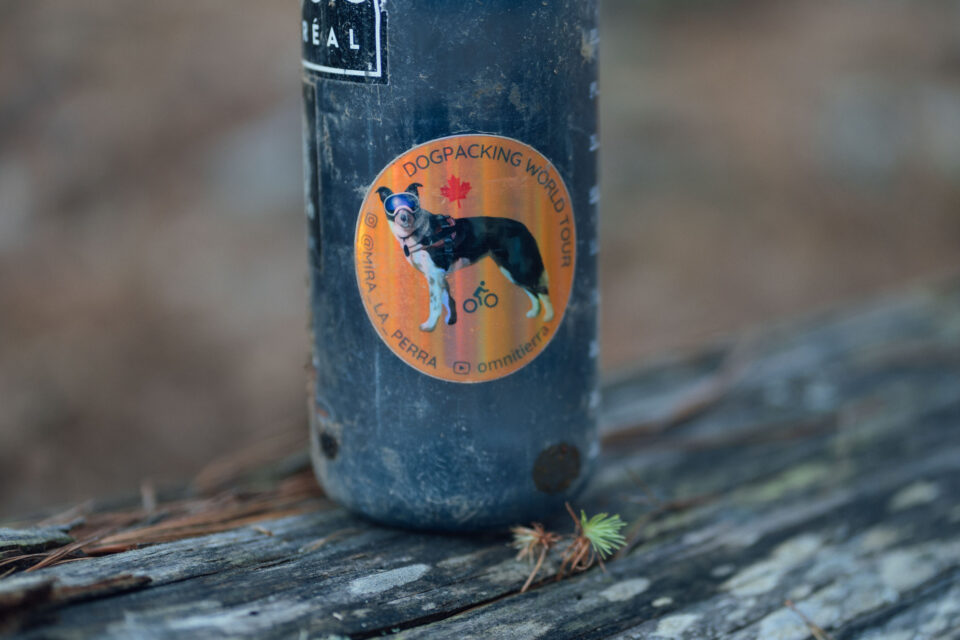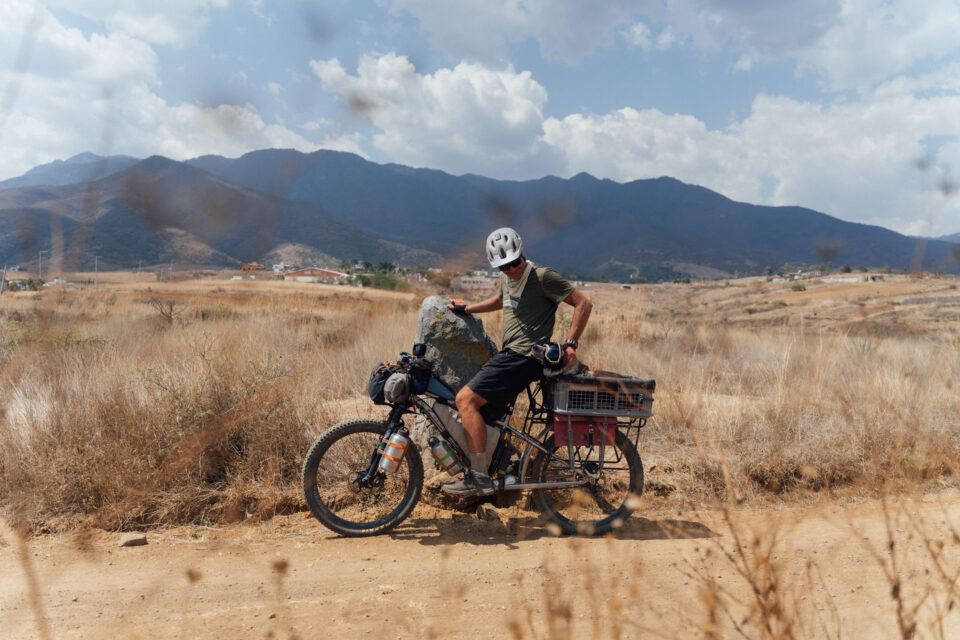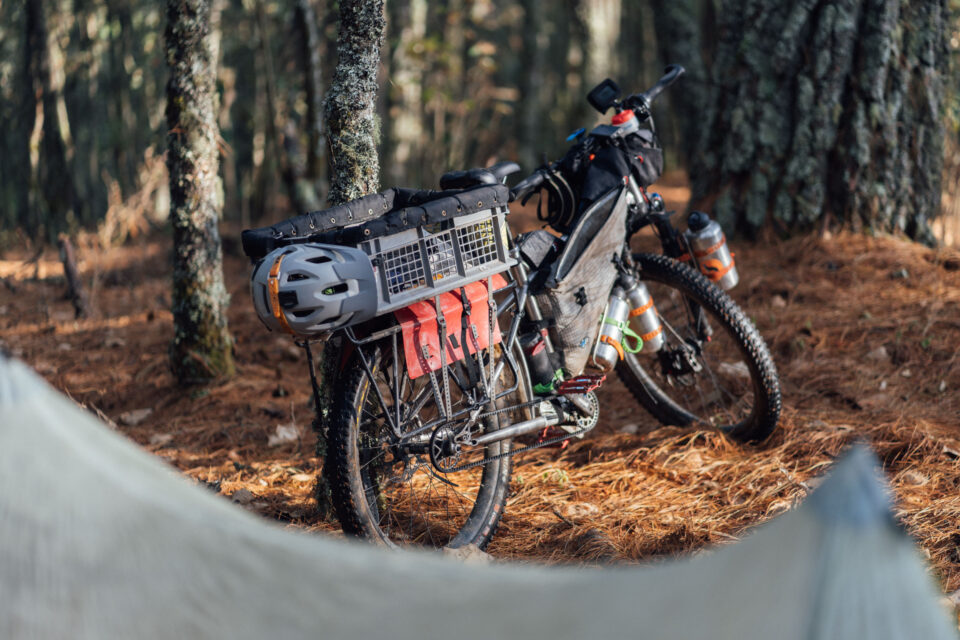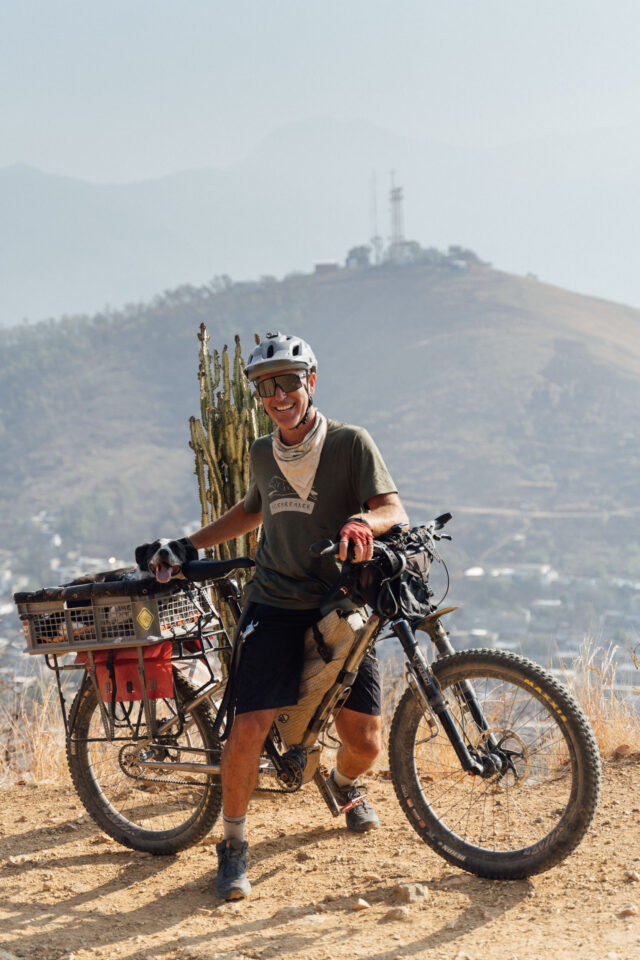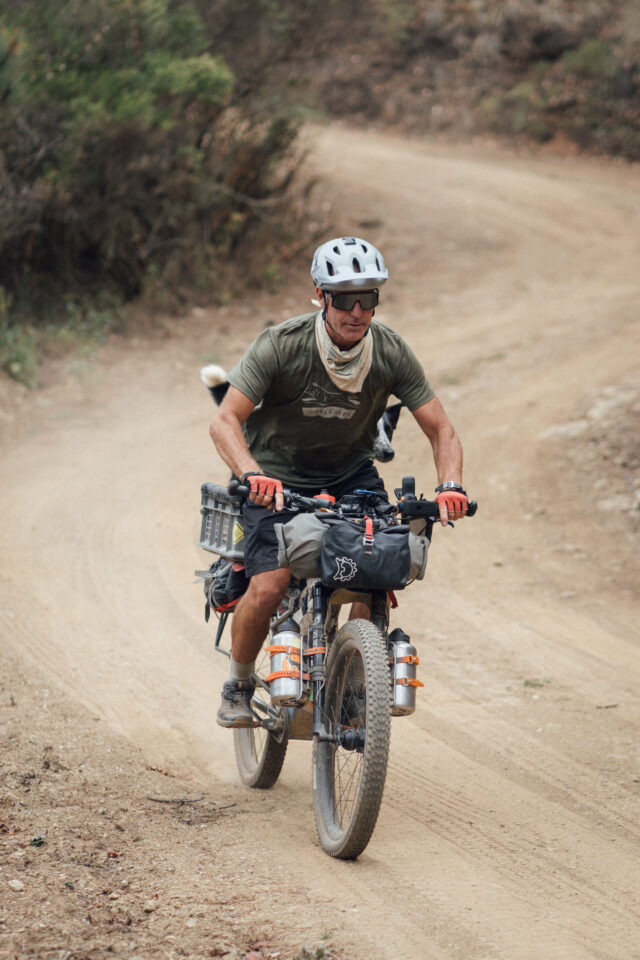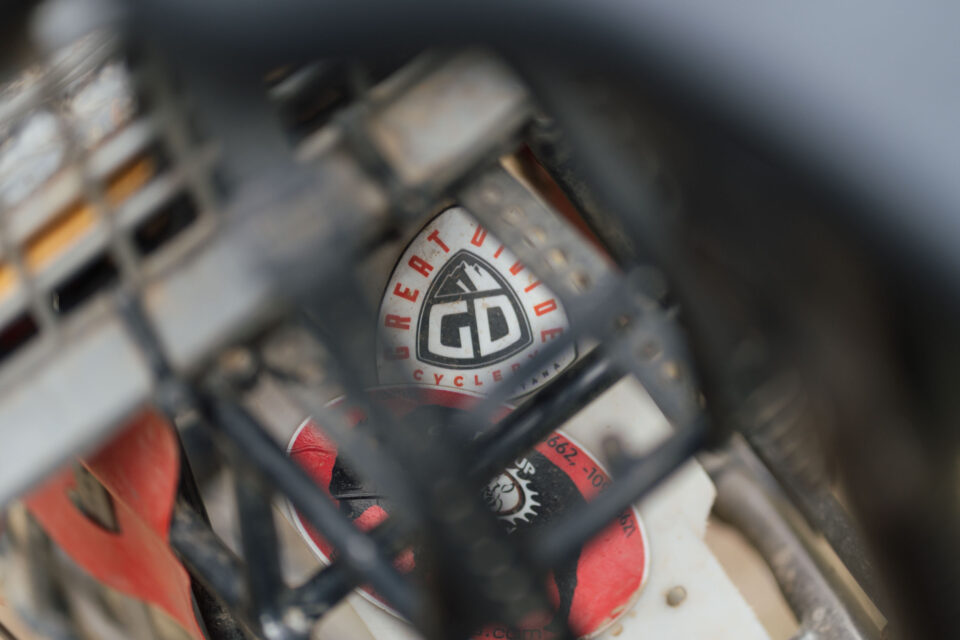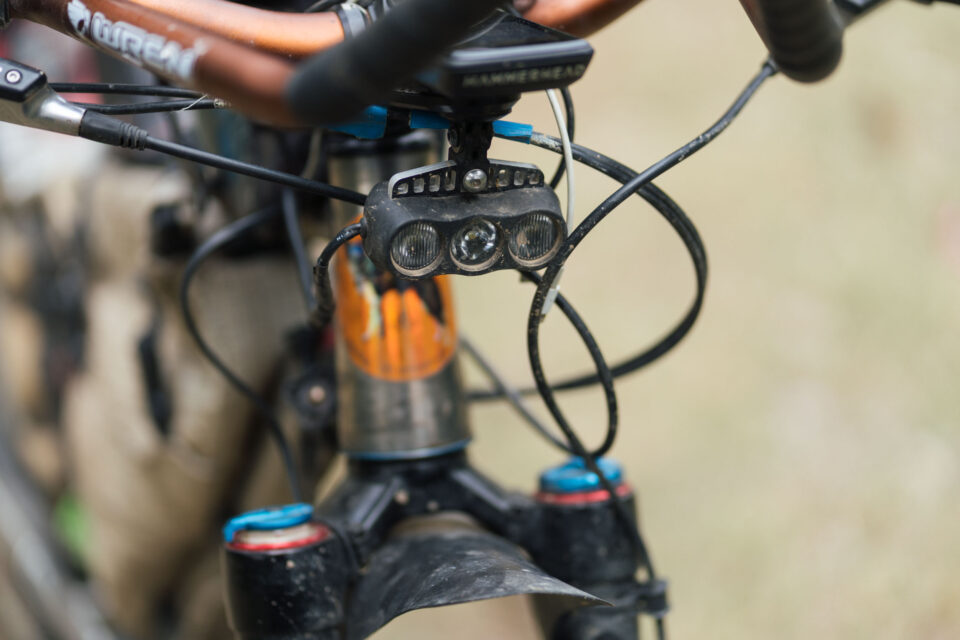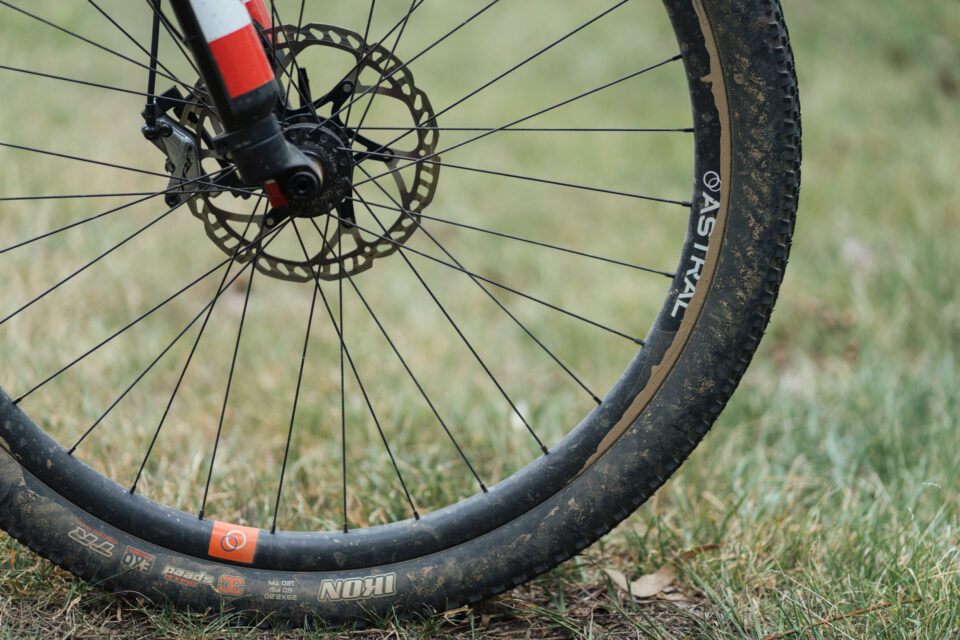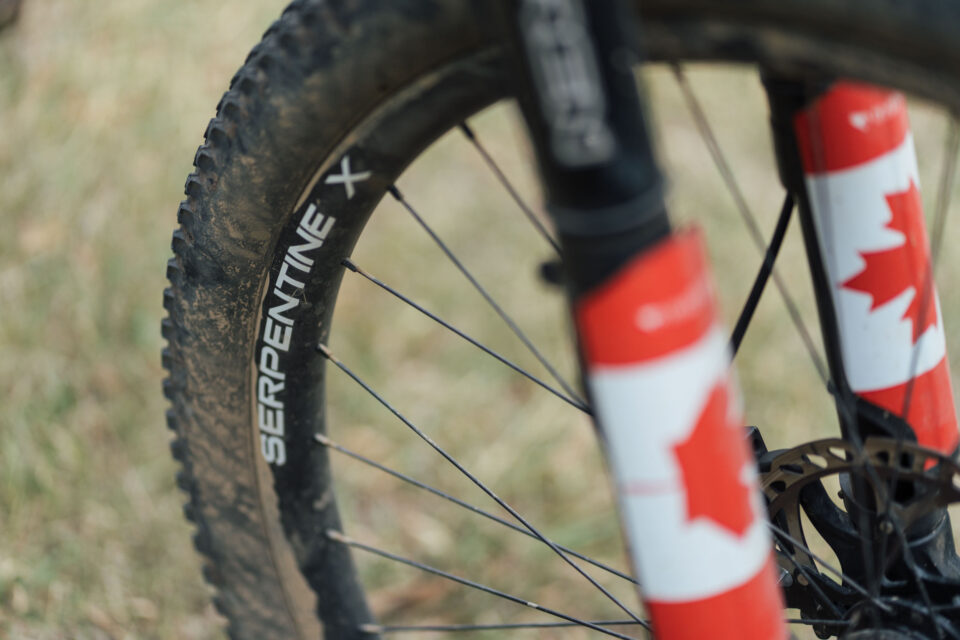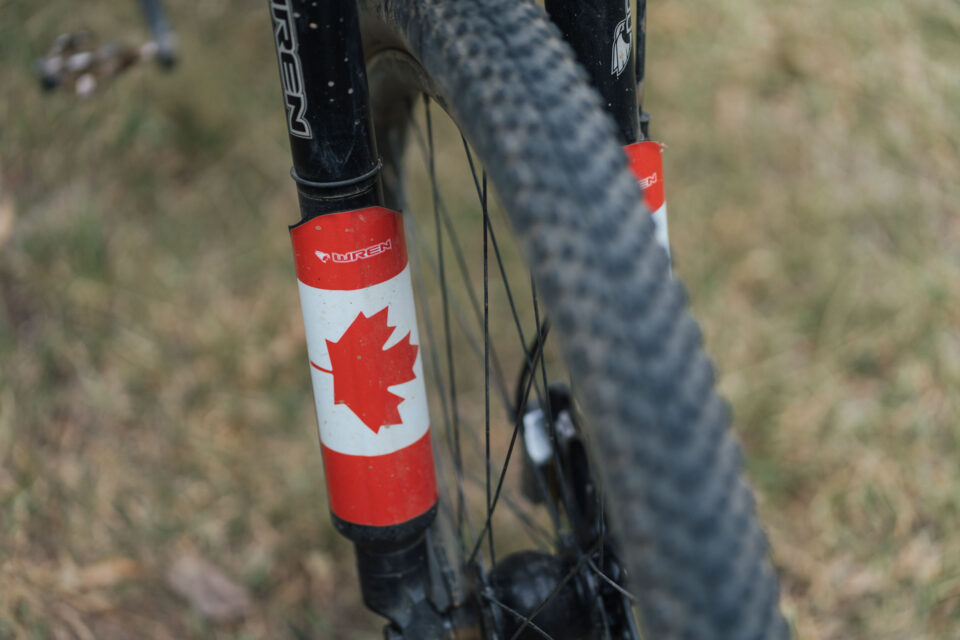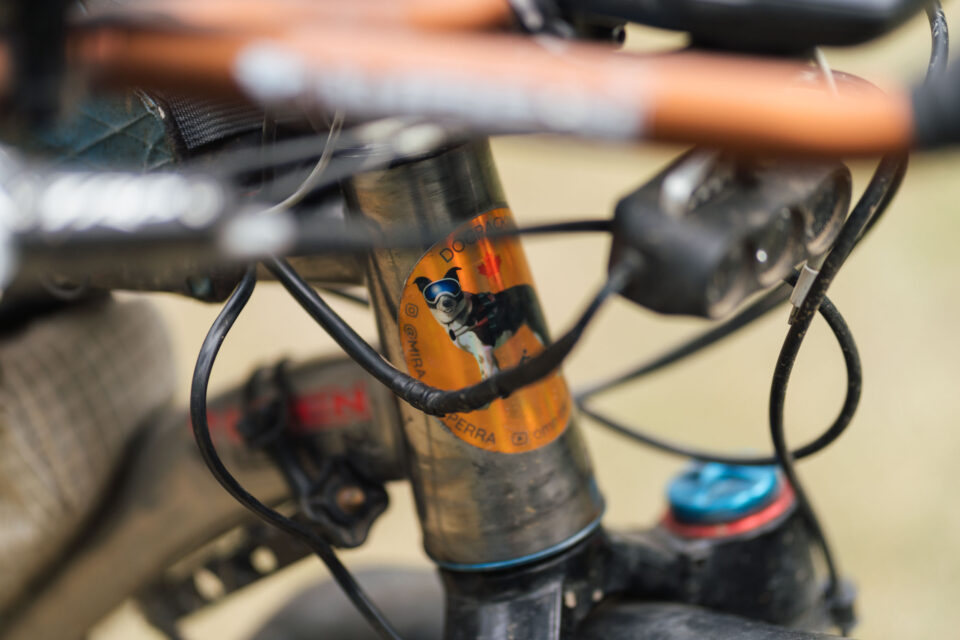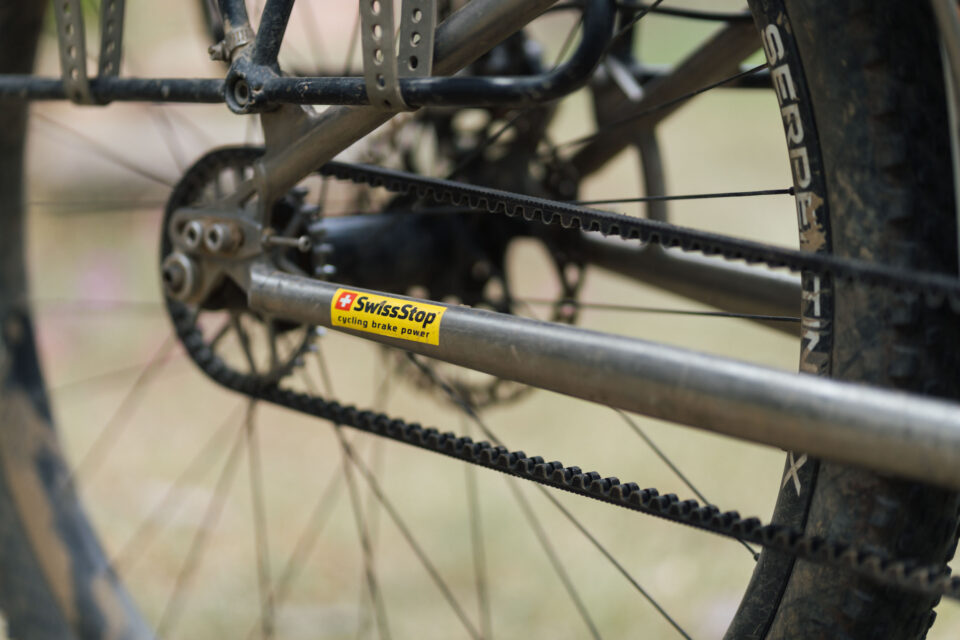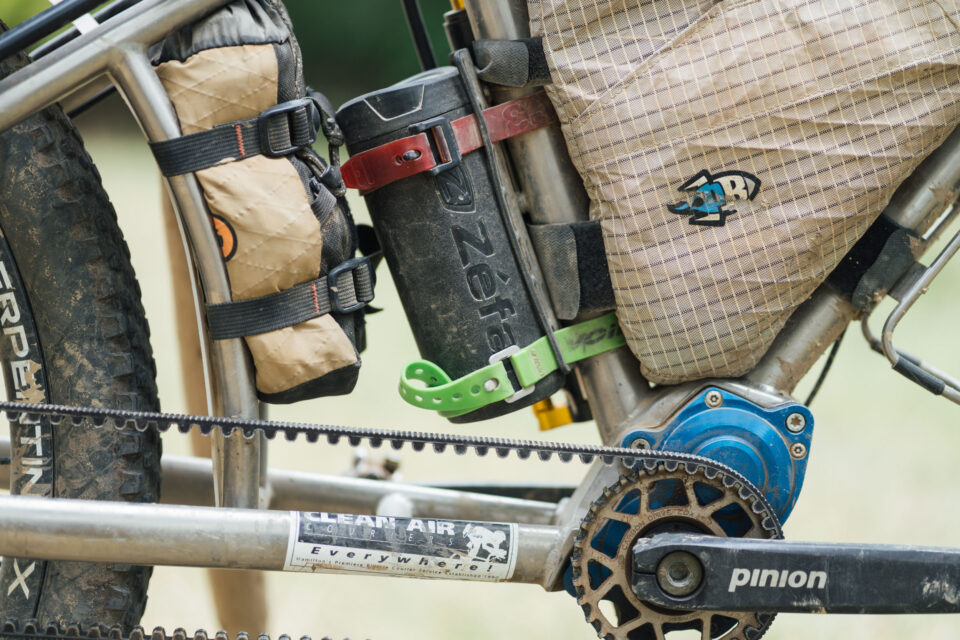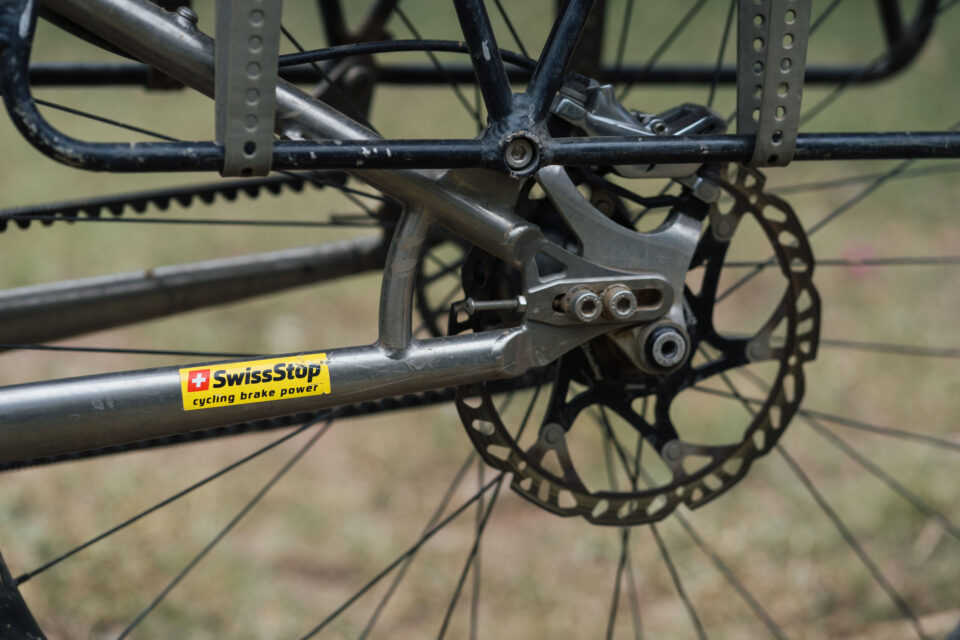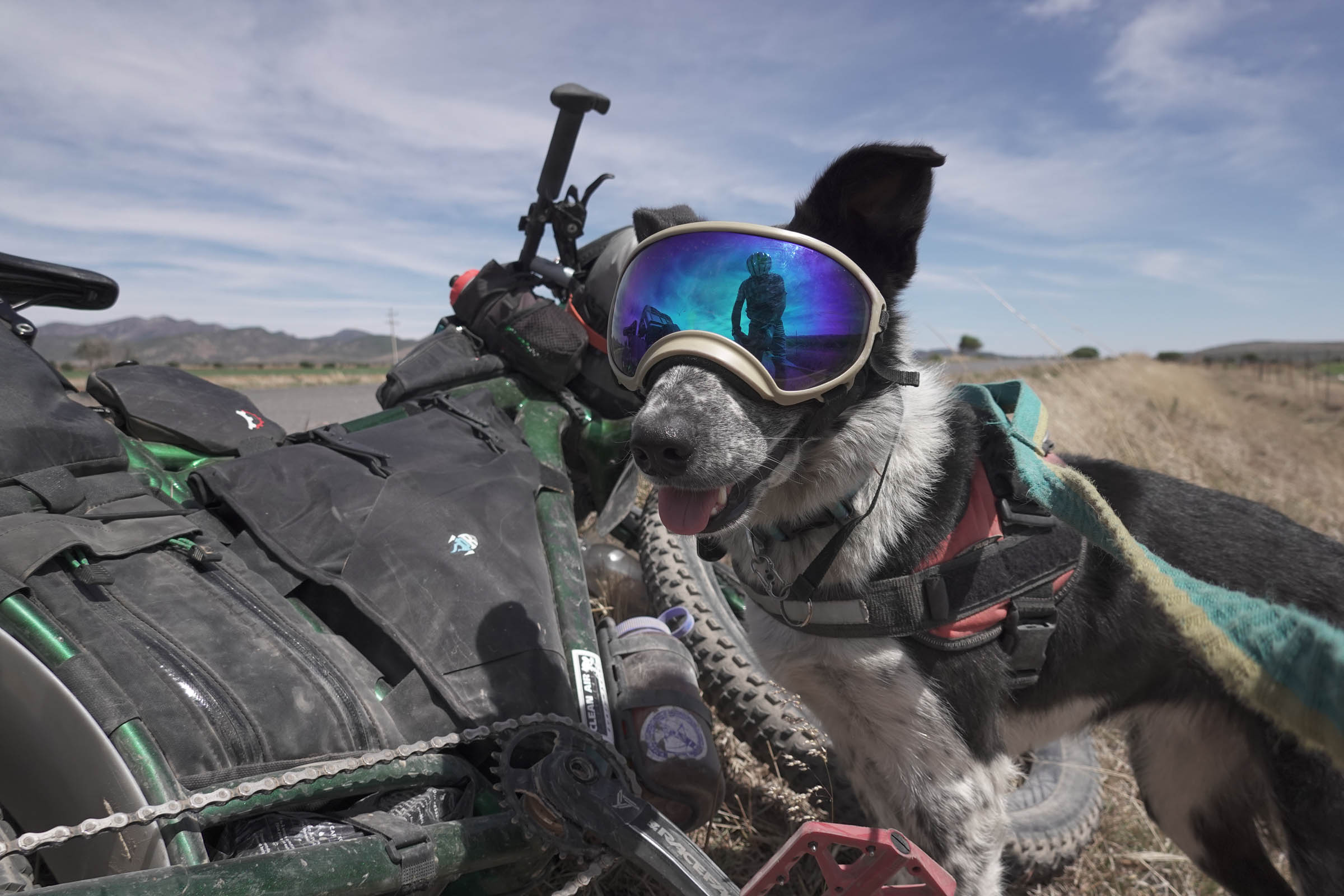John and Mira and Their Pinion-Powered Titanium Midtail
Share This
In this Rider and Rig, we catch up with dogpacking duo John and Mira shortly before the grand depart of the 2023 Tour Divide. Find out about John’s motivation to travel the world with Mira, learn why he chose to race this particular route, and enjoy a gallery of Mira in action. Plus, aspiring dogpackers can get granular with a detailed breakdown of their Pinion-powered titanium race rig…
For many, John and Mira need little by way of introduction. This internet-famous dogpacking duo have graced Youtube in a number of Ryan Van Duzer’s videos, shared dogpacking guides on this site, and brought smiles to the faces of passersby wherever they ride.
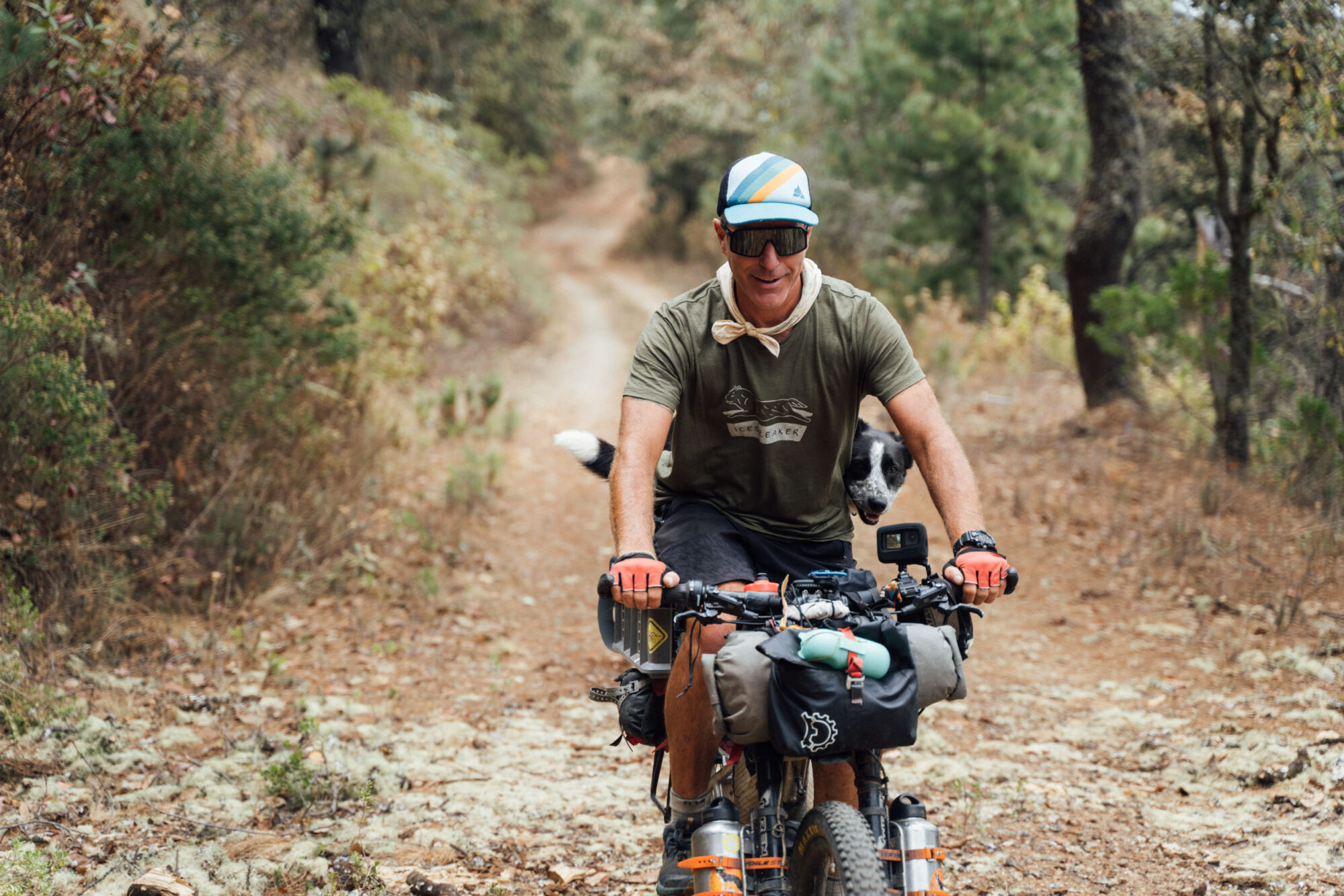
After settling down in Oaxaca for the season and taking a break from their world travels, John and Mira are now throwing themselves straight back into bikepacking by racing the Tour Divide – as the first dogpacking duo, no less! We had the chance to share some time together on a campout in the Sierra Norte and met up with them a few days before their departure to Banff to find out more about more about their aspirations for the event and inspect their updated, race-tuned rig.
First off, paint us some broad brushstrokes regarding your dogpacking world tour. Tell us about the rough route, approximate timeline, and motivation to take on such a vast journey with a dog.
In the broadest strokes, the route is an around the world bikepacking journey in all seven continents (six for Mira, as dogs aren’t allowed in Antarctica), focusing on as much self-propelled dirt as possible. It will likely take a number of years. In terms of the immediate future, once we’ve finished this year’s Divide race, we’ll continue to wend our way through Central America, having already ridden from our front door in Canmore, Alberta, all the way down to Oaxaca in Mexico. From there, we’ll follow the Andean Cordillera in South America to its end.
Antarctica, Australia/Oceania, Asia, Africa, and Europe still remain for this journey, and the choice of which continent to tackle next is not a straightforward one. There are enormous costs and logistics involved with an expedition to Antarctica (dogs were banned on the continent sometime in the mid 1980s, and we are totally fine with that). Continuing our ride with Australia/Oceania is more likely, but we will have some time to make this decision.
We tend to prefer riding in mountainous terrain. I have spent a lot of time working and recreating in the mountains, so it’s terrain that I feel at home in. The physical challenge is obvious, but maybe less so is the opportunity to come in close contact with the cultures that call these parts of the world home. Many mountain cultures share some of the same admirable traits of modesty, strength, and ingenuity honed by the place they call home. Also, you can almost guarantee you have the road to yourself. On these the big climbs, Mira is out of the basket and walking or trotting beside me. It’s always a joy to watch her experiencing the trail beside me. Motivation for this trip comes from a simple desire to see this beautiful world from a bike with my dog Mira.
I’m a dog lover, and the bond the two of you share is inspiring. Many readers will be familiar with Mira from your Instagram account, your YouTube videos, and those of your friend (and number one Mira fan) Ryan Van Duzer. But still, tell us how the two of you met.
Almost six years ago at a cattle ranch in central Alberta, Canada, I found Mira. The pairing of two working dogs, a Border Collie and a Red Heeler, she was born to work. I don’t have any livestock, so dogpacking is the next best thing, and she’s been doing so from the beginning.
When she was three months old we travelled from Canada to Spain where we dogpacked for close to five months all over the country. Two of our favourite routes in Spain include the Trans Pyrenees Route riding from the Atlantic coast to the Mediterranean Sea, as well as the Altravesur route, which we rode most of.
Young dogs can require special attention and care so they aren’t injured by overexercising on a trip like this (please consult your veterinarian before taking your dog bikepacking). This meant that I had to ride more of the hills with her in the basket. When the grade became too steep for that, we would walk together until the grade eased off. She spent most of the day in her well-padded Wald basket that we were using at the time with its custom Porcelain Rocket liner, so we could enjoy the descents down the other side. Since that time, we have ridden tens of thousands of kilometres together.

As bikepackers, we aspire to paring down our belongings and running a lightweight setup, given the extra challenges of riding off road. But, clearly, dogpacking brings with it a whole new set of gear, as well as additional food and water, let alone the weight of a dog! What other aspects do you have to consider on a bikepacking world tour?
There are many challenges that come with travelling with a dog. The first and most obvious one is the added weight to your bike. In our case, there is at least an added 23 kilograms (50 pounds) to the overall set up. Mira weighs in at about 20 kilograms (44 pounds), and with the addition of food and water, it’s easy to add another 5 kilograms (10+ pounds). In terms of total weight on our world tour, our setup sits at around 70 pounds, but it can easily reach 80 pounds in the winter.
Additionally, not all accommodations will accept dogs. The ones that do almost always charge an extra fee and may have other specific rules. Air travel is logistically challenging and even more expensive.
But all these aspects are minor when compared to the joy dogpacking brings to us and others. I often catch people with broad smiles on their faces as we ride into a village together. Countless times, strangers come up to us to ask questions and want to pet Mira. Of course, these days, Mira poses for a lot of selfies with people too. It’s a beautiful way to pass through the world with everyone smiling in your direction and giving you a big thumbs up.
You’ve ridden across the US on a number of occasions. Is the Great Divide Mountain Bike Route a route you’re familiar with already? What motivated you to race it?
From high school to my mid 20s, I raced at a high national level on road and track with a little MTB and cyclocross to round things out. So, I have a fair amount of racing experience on different types of bicycles, but nothing like the Tour Divide.
This will be our sixth and seventh time riding across the USA north or south. In 2020, we rode about half of the GDMBR with Ryan Van Duzer. We had ridden much of this route and the Western Wildlands Route in early winter conditions previously. When Ryan Van Duzer came down to Mexico this December to join us on one of your classic Oaxaca vueltas, we were reminiscing about some of the great rides we have shared. The topic of the GDMBR/Tour Divide came up.
The next thing I knew, I had radically changed our schedule to train for this year’s race. The idea of challenging ourselves in this way is incredibly appealing, and just as I had hoped, what we’ve already experienced during the preparation and training phase of this process has inspired me to see what’s possible for the remaining portions of our trip around the world.
In terms of keeping my motivation going over such a long journey, having a new and sufficiently difficult challenge has really created a new focus for us. Committing to all the training and preparation for myself and Mira has been an incredibly rewarding process. Regardless of how long it takes us to finish the race, it’s already been a success. Now we just get to enjoy the process of racing and meet a lot of new people on the route.
I know your priority is always Mira’s well-being. But do you have any idea how fast you plan to complete the Tour Divide? Or are you just out there to put in some big days and see how it goes? You mentioned you’re the first dogpacking duo to take on the race, and that Mira may have her own special dot for us to watch!
Mira and I are definitely in a category of our own for this race, so I hope that TrackLeaders will give us our own icon (a little doggy) or colour for people to follow along. Publicly stating a time goal is hard for an event like this. It is a long route with changing conditions and terrain. Also, we have never raced together before. All that being said, we are riding for a competitive time overall – something in the neighbourhood of three weeks. Which side of that 21 days really depends a lot on conditions, as it does for all the competitors. Of course, we need to factor in some time for Mira to visit with all her fans, old and new, along the route.
Mira’s health and safety are always my priority. I will not compromise her health for a better race time, and we have a veterinarian that we consult on a regular basis. We have both put in a lot of preparation, but then so has everyone who turns up in Banff or Antelope Wells with a GPS tracker and plans to ride as fast as they can.
I’m sure many dog lovers are curious to hear about the extra challenges of bikepacking with a dog, especially in a race scenario. For instance, how much extra water and food do you expect to carry? And how many hours a day do you expect her to be running versus the time she’s in the basket?
Mira and all her supplies add a substantial 25 kilograms (55 pounds) to the bike. Just like with my food and drink, I need to be strategic with hers. I normally carry about 30 percent extra water for her, plus she is good at foraging for water en route (I assess water quality for her). It’s a sight to see her drinking while standing in the basket as we roll down the trail. Two-kilograms (4.4-pound) bags of dog food are the smallest commonly available along the way. Normally, I would carry all of this, though during the race, I will only carry enough to the next reliable resupply. She will get lots of snacks and water during the day. Events like this are an eating competition as much as they are an athletic endeavour.
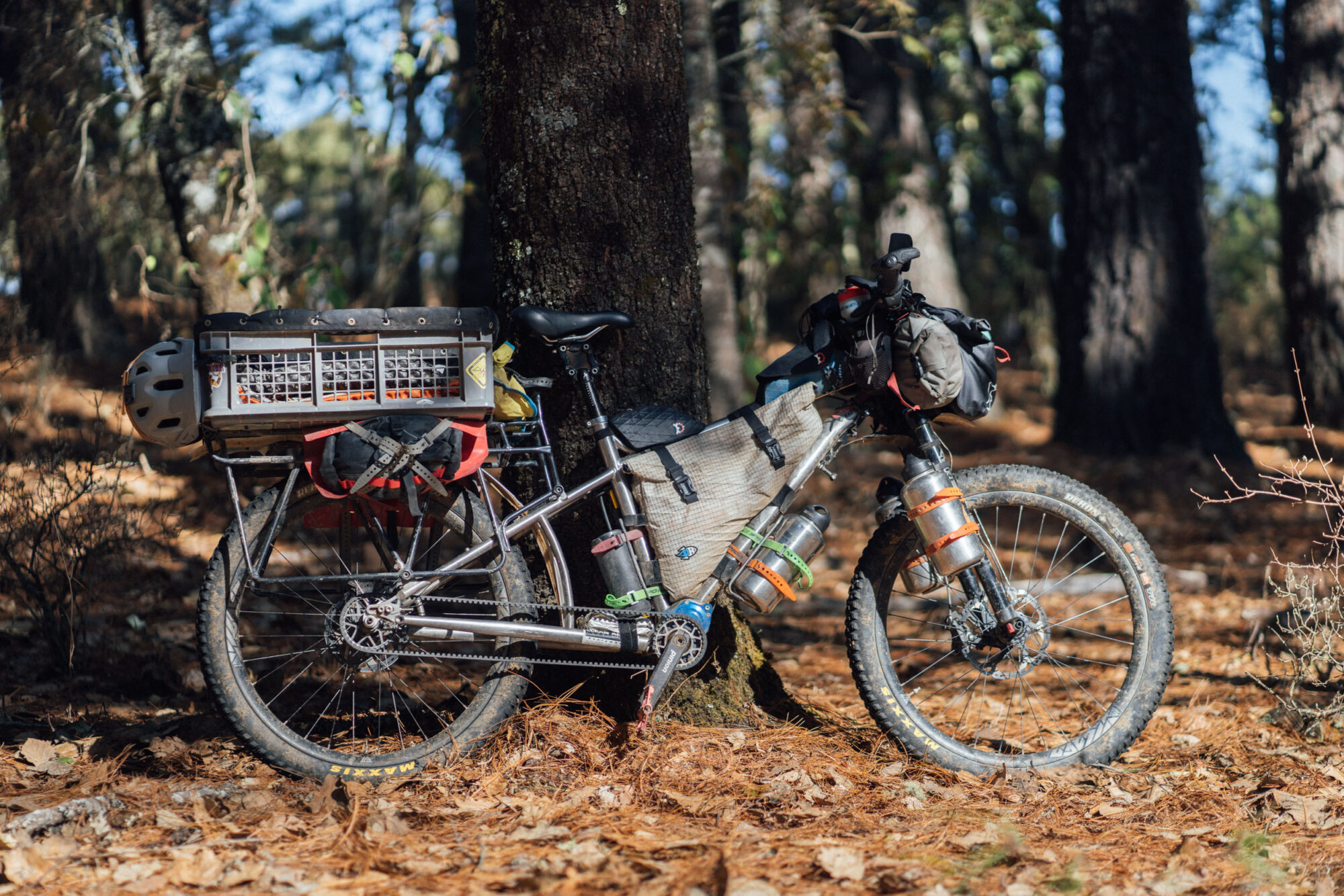
Mira is an incredibly fit and robust dog. Our method of dogpacking means she is out of the basket on steep climbs where the speeds are lower. She is also out in singletrack when it improves safety and fun for us both. On the speedy downhills, flats, and basically any time the speeds are high or the surface dictates, she is cruising in her basket on the back of the bike. Note that our custom bike has about an eight-inch longer wheelbase than a regular mountain bike to better balance the load. Even with all that time in the basket during our normal days of dogpacking, Mira can run an estimated half or full marathon. Almost none of it is in a straight line.
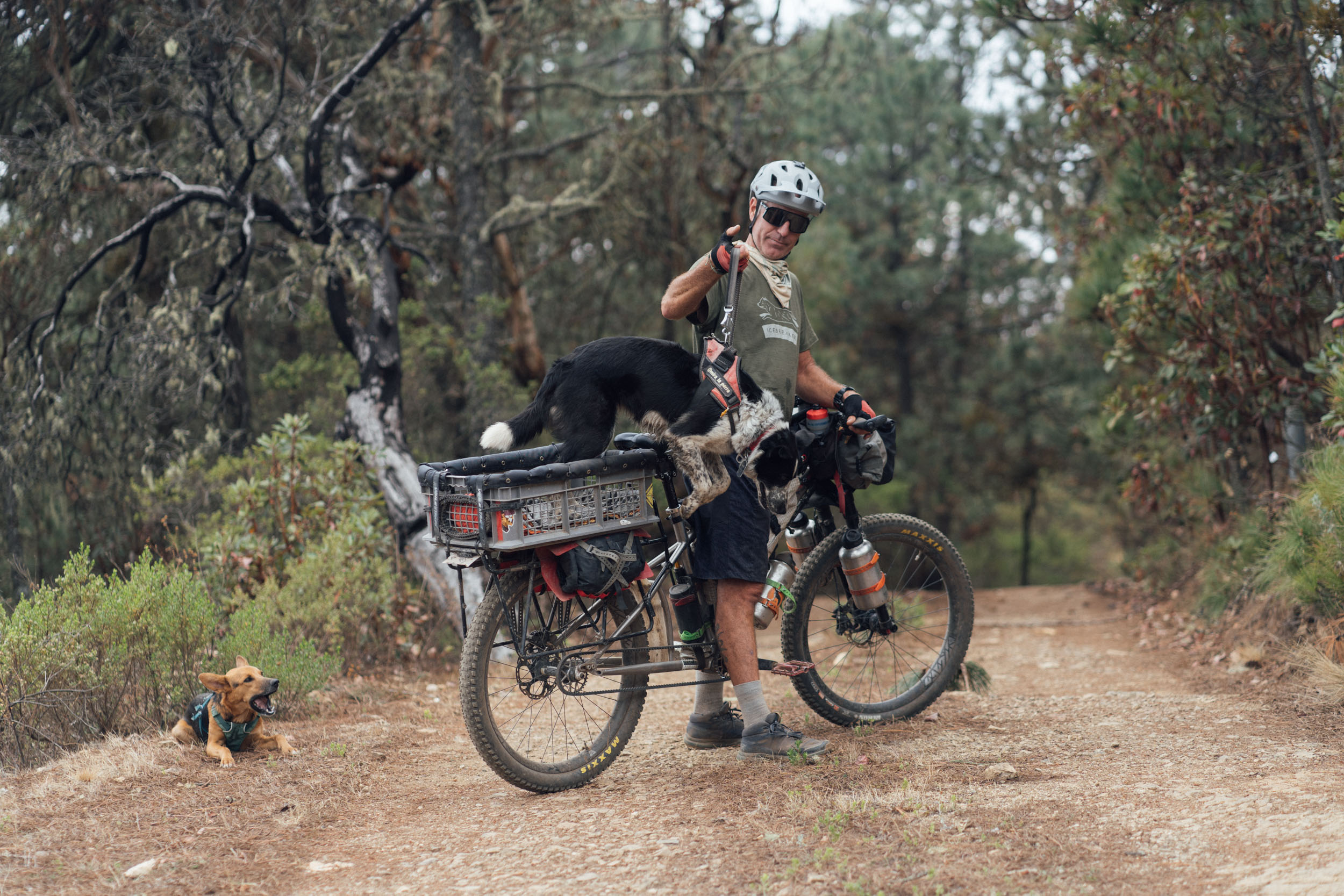
As you can see in many of our YouTube videos, Mira is often connected to me with a leash at her harness. This helps me to lower her to the ground when she jumps out on command, and also aids her in jumping back into the basket. The basket is about a metre off the ground and I come to a complete stop for her to jump back in. On rolling terrain, she could be in and out of the basket about 100 times a day.
Are animals, wild or domesticated, ever an issue? Or even other dogs?
On a course like the Tour Divide, you’re almost guaranteed to cross paths with livestock, dogs, and possibly some local wildlife. In the northern portions of the route where bears are possible, Mira will be on leash the entire time. As I’ve mentioned before, she spends most of her time on a leash so I can help her in and out of the basket and also control her pace a bit better. She never seems to bother looking at the map to know how much further we have to go or what the terrain is like. I’m really fortunate that Mira is non-reactive to barking dogs. With the amount of time we’ve spent in Mexico, it’s something I’ve come to appreciate as around every corner in every village there is a dog, and they all speak Mexican Spanish. Mira’s recall is excellent around other animals. So, I’m confident that we won’t have conflicts with livestock or other large animals we might encounter on the trail.
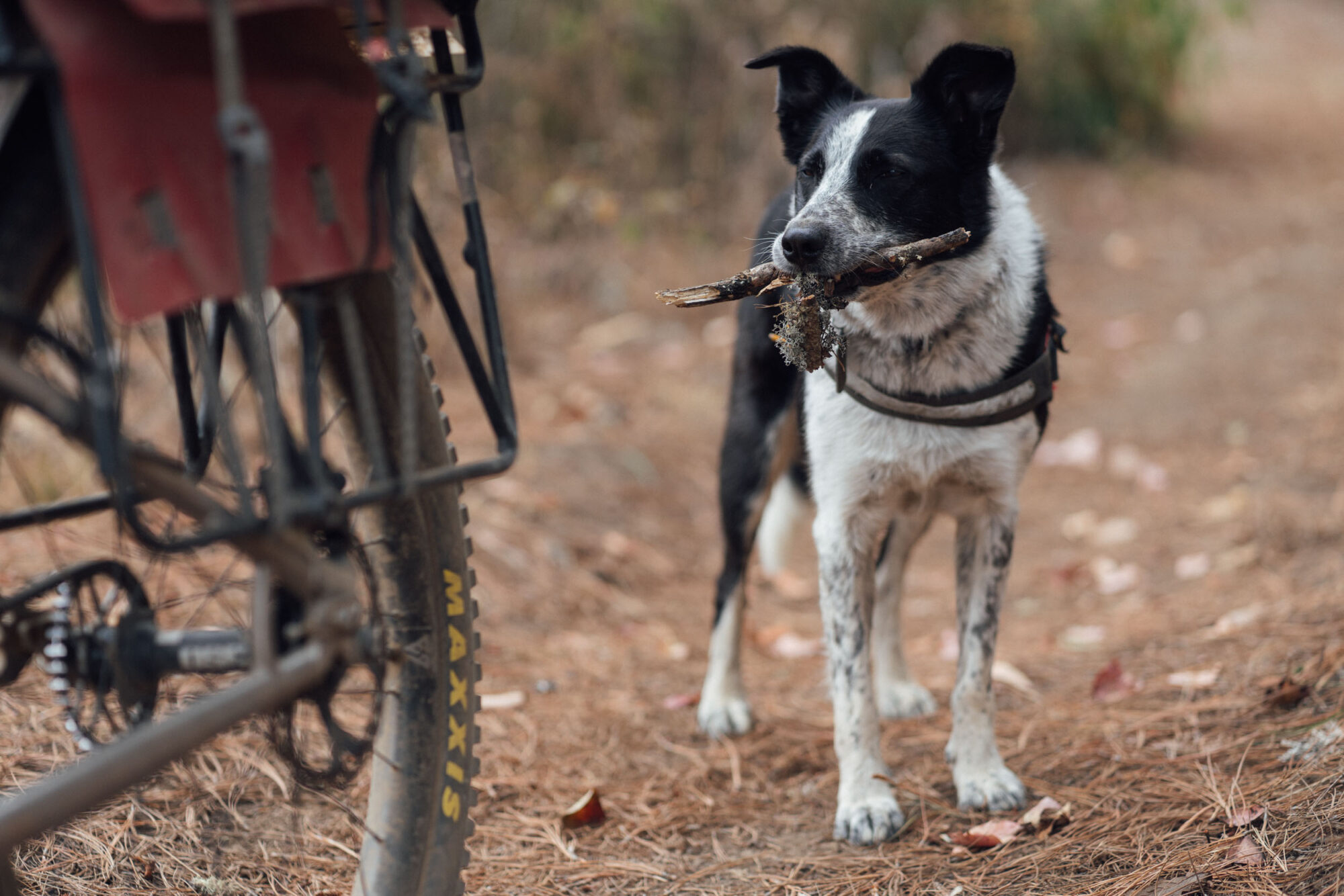
Bears are in a category of their own. We will follow the best practices to avoid a conflict with bears. Because Mira spends most of her time in the basket, we shouldn’t see much difference from other riders. On the steep climbs when she’s out of the basket, we would have more time hopefully to become aware that a bear is close by. Mira is actually a very good bear detector as shown in this YouTube video, where she starts to bark from her perch in the basket before I even saw the bear. If it wasn’t for Mira, I wouldn’t have noticed it at all.
What kind of extra gear do you have to keep her healthy? How about Mira-specific setup choices?
It’s not a lot, but it’s all carefully chosen to help us be safe and efficient. Mira gets a regular flea and tick as well as anti-parasite medication. I also carry a few other medications to deal with specific things that might come up during travel like this. She also has some gold framed RexSpecs dog goggles to help protect her eyes from wind, debris, and damage by the sun—the same reasons I wear sunglasses. Plus, we look cool. To protect her paws, she will wear some robust booties for most of the race. Normally, I only carry a lightweight set to help her deal with the prickly things or hot asphalt. In a pinch, baby socks could work as well.
For the race, she has a customised harness that allows me to put water or ice into pockets on both sides. This pairs up with the elasticized runner’s leash. On those bad weather days when we would normally just seek shelter, she has a new high-vis rain vest. RuffWear makes all three of these products. Mira could really use another sponsor. A Buff around her neck is great to help her thermo-regulate. Dry equals warming. Wet equals cooling. I use my Buff the same way.
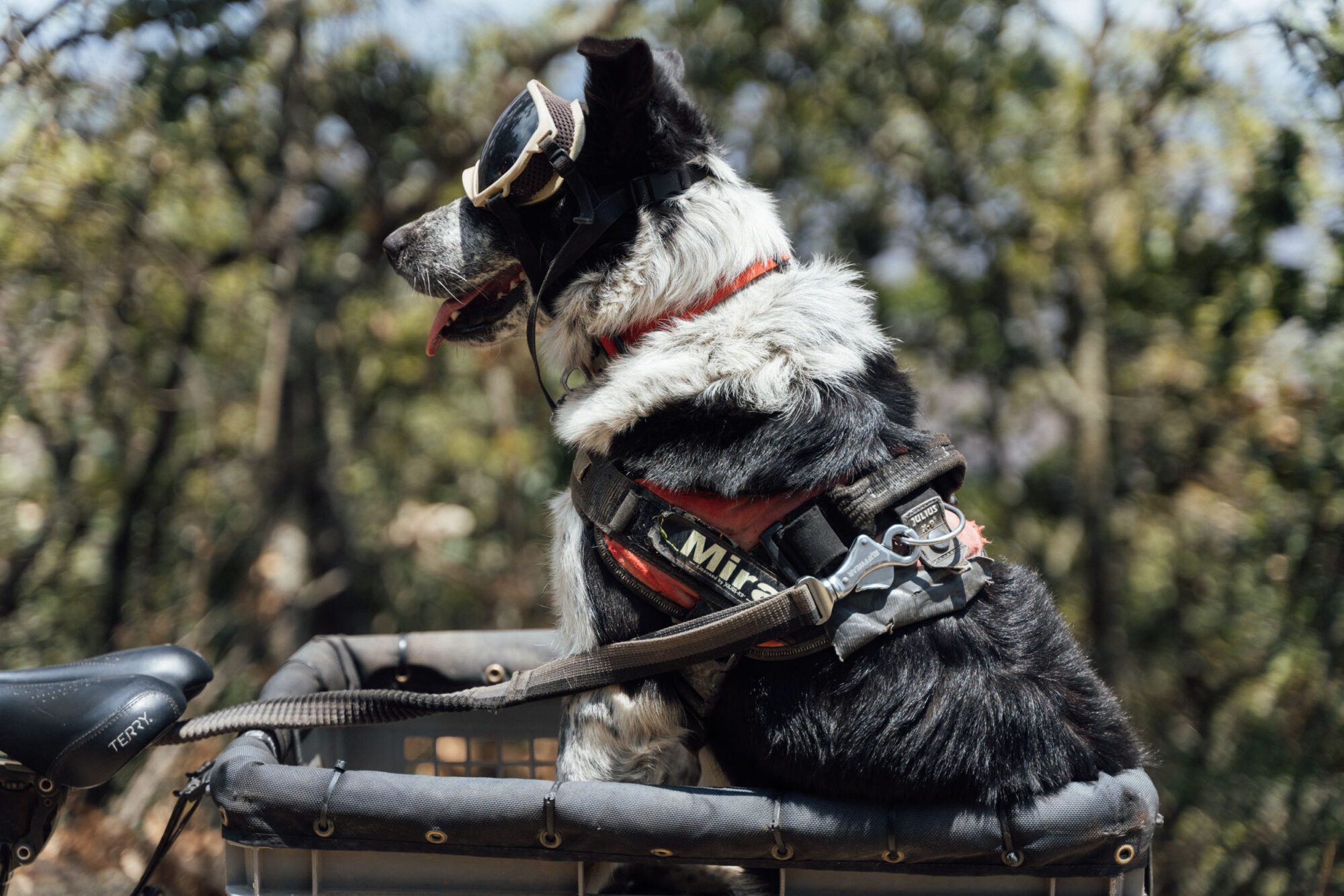
The basket is well padded for comfort and also increased safety since it protects her from the hard edges over the roughest of terrain. The basket – made by Uline and measuring 24 x 16 x 8 1⁄2″ – was selected to give her a snug and secure but still comfortable fit. All the details about how we use it can be seen in this YouTube video.
How will you handle inclement weather with Mira? And do you have a particular camping setup? In fact, does Mira have her own sleeping bag?!
As a Border/Heeler mix, Mira is pretty robust. I mentioned her rain vest above. Normally when dogpacking, we have an Uber lightweight Durston tent for shelter (it’s nice to support a Canadian brand), and I can share my puffy jacket with her if needed, though this is rare. On the Tour Divide, we won’t have a tent. This means we will have to be strategic, creative, and a little lucky with the weather. That could mean a hotel, a random outbuilding, or a broad-limbed evergreen tree to shelter from the cold or wet. As part of planning, I’ve contacted some hotels on route to confirm their policies about pets. I also have the BringFido app loaded on my phone. Having a dog at paid accommodation almost always adds a cost. Sometimes, it means we are screwed and are going to suffer more than we would like, but isn’t that part of the Tour Divide?
I’ve seen the two of you out training in Oaxaca, covering epic distances and devouring massive climbs like it was the best kibble money can buy. Tell us about your training and time in Mexico.
Oaxaca is possibly the best place to train for an event like this. It is blessed with countless quiet dirt roads and trails. There are massive climbs that are dirt, steep, and high elevation. The days in southern Mexico are longer during the winter than I would have if I was training further north. Consistent weather and the small villages are well served with comedores (small restaurants) serving up tasty traditional Oaxacan cuisine are also a big plus in Mexico.
It’s been a steady progression since we started training for this event. We both had a reasonable level of fitness to build on. During the months, we have put in consistent training and recovery. We have seen some pretty positive results. Routes that are usually scheduled for a comfortable three days we do in a single day. The San José del Pacifico route that Ryan filmed for his YouTube channel (see the full series here) is usually done in a challenging seven days. Mira and I did this route as a training session over two and a half days with limited night riding.

We were pretty fortunate while in the Oaxaca area to be able to stay at Casa Raab. This beautiful wooded 40-acre property has been in the Raab family since the mid-1950s. Tony and his wife Rebecca operate a dog sanctuary called Friends of Megan on the property. Mira had many puppies and dogs to socialise with. Tony creates some fine Mezcal using traditional methods and his own agave. It would be hard to imagine a better basecamp to stage training from. This would be an ideal place to take advantage of all the awesome Enduro riding that exists in the mountains above Oaxaca de Juárez too.

Build Kit
- Frame Chinese-built custom titanium dogpacker based on the Salsa Cycles Blackborow
- Fork WREN Sports inverted 110mm travel fork
- Headset Cane Creek 110
- Stem WERN Sports Crazy light stem
- Handlebar WREN Perseverance Adventure Bar with integrated aerobar
- Grips Ergon GP2 grip shift version
- Brakes TRP Evo DH
- Rotors SwissStop Catalyst Pro 203mmF, 180mmR
- Shifter Pinion grip shift
- Rear derailleur What’s that?!
- Gearbox Pinion P1.12
- Crank and chainring Pinion 175mm, 32T SS
- Cassette Pinion 34T SS
- Chain Gates Carbon CDX belt
- Front hub SON 28
- Rear hub Onyx Fatbike
- Spokes TBC<
- Rims Astral Cycling Serpentine Carbon X 29”
- Tires Maxxis IKON speed race 2.2F/ 2.3R
- Seatpost Cane Creek Thudbuster ST
- Saddle Specialized Bridge Mimic
- Pedals Shimano XT SPD
- Frame mounts Various
- Other notes K-lite Bikepacker Ultra, Qube rear light, Salsa Blackborow rear rack, Uline 24x16x8.5″ crate
I see you’ve made some changes to your setup in readiness for the race since I last saw you. Talk us through them.
It almost feels like “new-bike day” for us with so many changes. One of the biggest performative changes is from the new Astral Cycling wheel set that moves up to 29er from the 27.5+ wheelset I was running previously. The narrower Maxxis tires with a less aggressive tread pattern also helps a lot. This was done to reduce rolling resistance.
The bike has a new Wren suspension fork and a set of the Persuader aero MTB bar. This helps me comfortably assume a more aerodynamic position, plus it provides another position to use during the very long days of the Tour Divide. I put my flat pedals in storage and am now using clipless pedals along with a stiff mountain bike shoe. The Tour Divide has very few hike-a-bike sections, and those are not coming as a surprise, so I’m prepared for them.
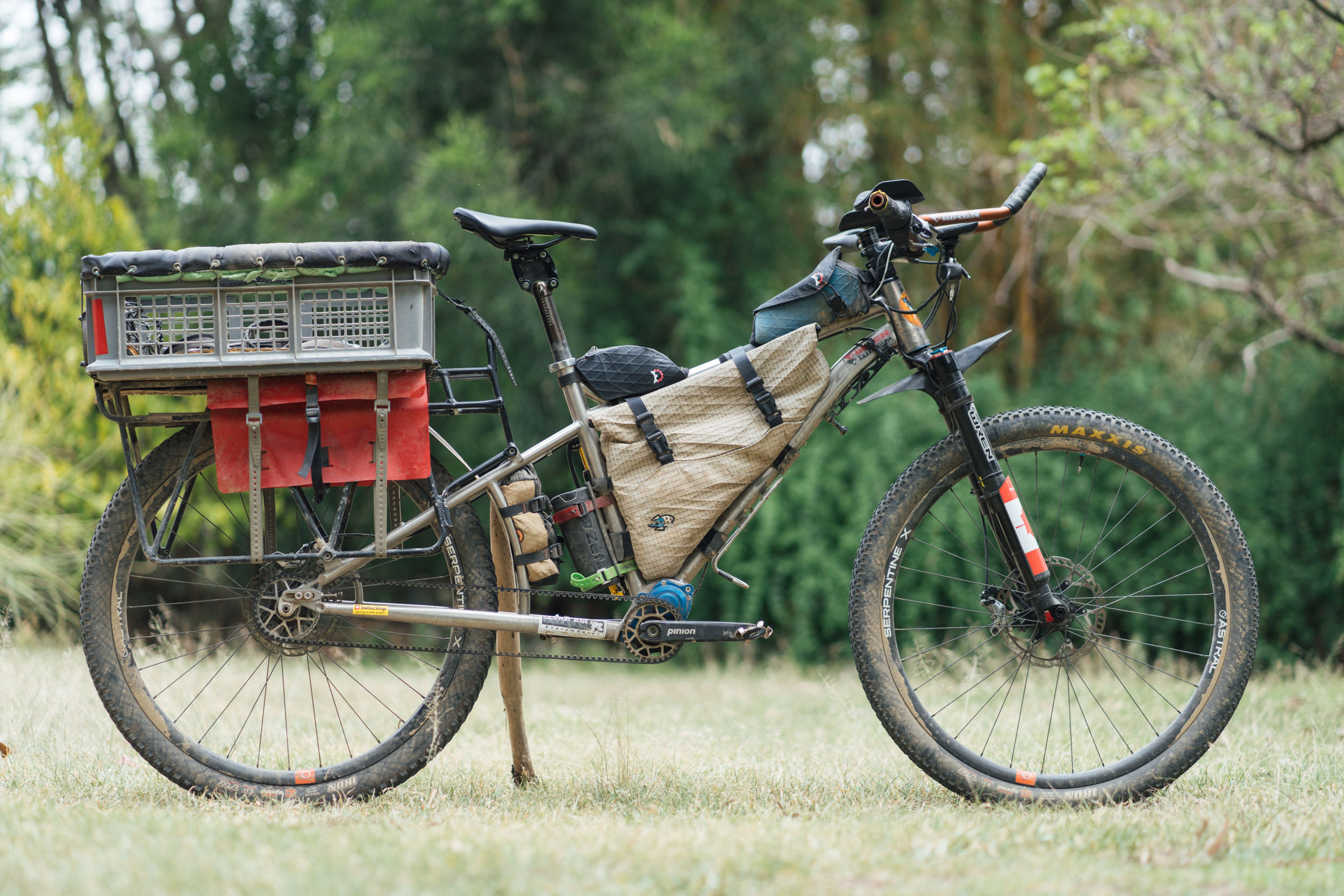
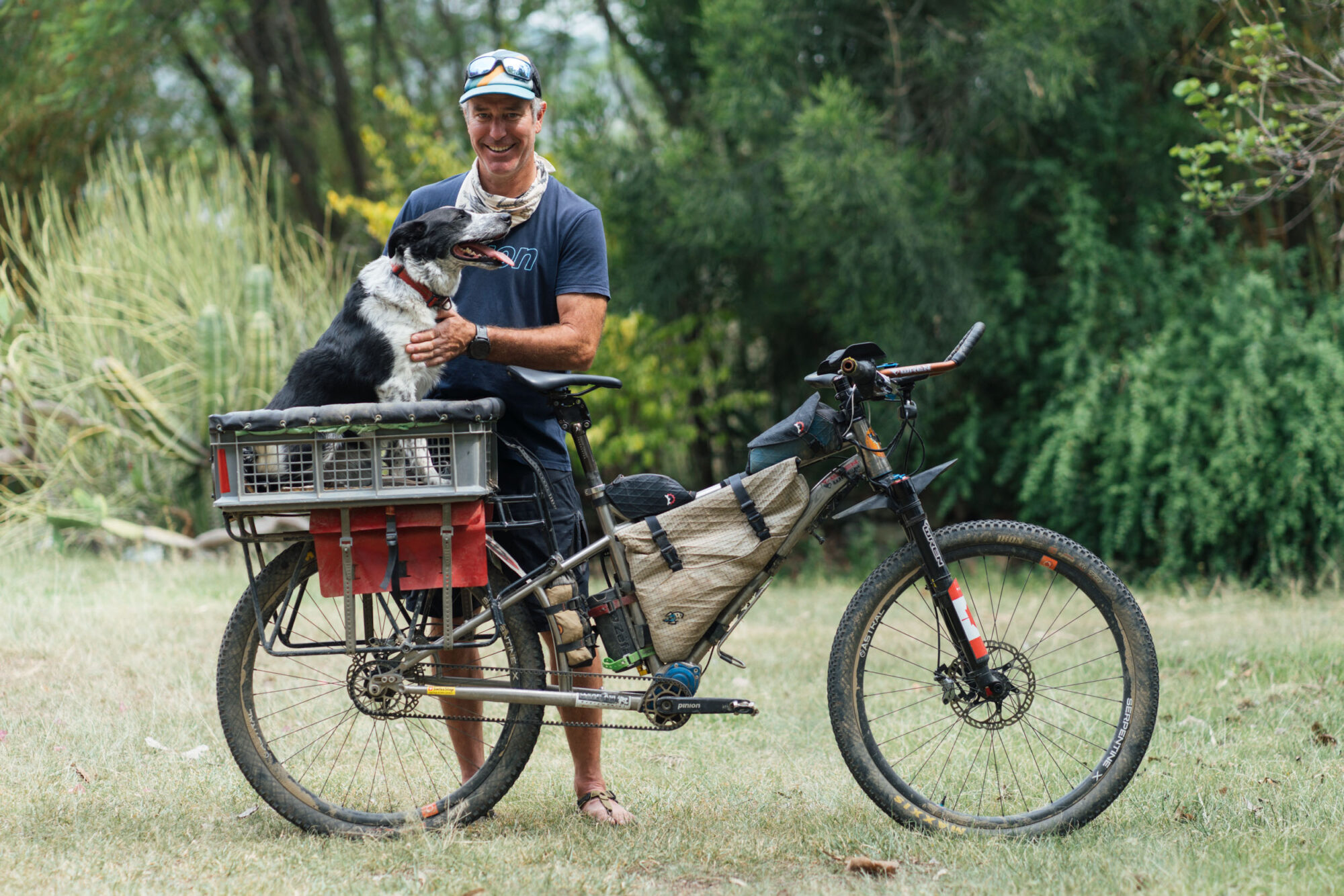
Another change comes with my clothing system, which also includes a hydration pack and aerodynamic fitting cycling clothing. I do look at it as a system where all the pieces work together to enhance my comfort when worn together. I took the same approach when choosing the apparel items for Mira as well.
I know you built your custom Ti midtail around the Pinion drivetrain, which you’ve been running since the beginning of your world tour. How is it working out for you?
As one of the main parts of our bike I have not changed, the Pinion Drive and Gates Carbon belt system works incredibly well. It provides us with an enormous range of gears that is nearly impervious to the weather or all the kilometres we throw at it, though we will start the race with a fresh oil change. That’s about all we ever have to do with it.

Some people will talk about the efficiency of external derailleur and chain versus the internal gear systems that are available on the market. This is definitely true with a new and clean drivetrain. By the time riders reach midway on the race, both of those states are a distant memory. All riders struggle to keep their drivetrain clean and will need to replace their chain at least once during the event if all goes well. I have learned to love the simplicity of operating the Pinion and Gates system. All I will need to do is keep the belt clean and rub some soap on it if the conditions are dusty and it starts to squeak a little bit. The Pinion gearbox won’t need an oil change until we have ridden all the way back up to Canada. This oil change is incredibly simple to do. In fact, after unpacking my bike from our flight to Canada, I did an oil change. With the simple Pinion kit that includes oil and a syringe, the whole operation took just 10 minutes. This included watching the video to make sure I hadn’t missed remembered how to do it.
The Pinion/Gates system helps make the bike go. To go fast, you need to be able to stop the bike under control. I’ve made a big upgrade to the braking system by using SwissStop rotors and pads. With Mira’s added weight on the bike, we ask a lot of our brakes. Without power and proper heat management in the braking system, we can’t confidently go at high speeds. Braking is really one of the most underrated upgrades that you can make to a bikepacking setup. I also make sure to take the time to properly bed in new brake pads. The few minutes it takes to do this improves performance and adds longevity to our brake pads.
What are your immediate plans after the race? More dogpacking, I take it?
After the Tour Divide finishes, we will ride back north to Canada before returning to Mexico, as this timing allows us to avoid its rainy season. This will give us the opportunity to follow several other established bikepacking routes. The AZT (without the Grand Canyon), The Plateau Passage (from Kanab to Durango), The Colorado Trail (NOBO), with a visit to Mira’s #1 fan in Boulder, CO. The we will rejoin the GDMBR northbound back to Canmore, Alberta. This route takes us to some of the most beautiful parts of the American Southwest. From Canada, we will fly back to Mexico. By this time, the rainy season will be at an end for our ride south.
This endeavour sounds like a serious financial undertaking. How do you pull it off? What’s the best way for readers to follow along with your world tour, and is there any way they can support you?
When I’m not bikepacking, I’m a rope access supervisor and a mountain safety consultant. The work is diverse and challenging. It allows me to work in different locations around the world for blocks of time, which means I can take months off if I live a frugal life.
Over the last year, I have played at being a YouTuber. But as I don’t always enjoy the experience, or the effects that social media can have on me at times, I also sell Mira T-shirts, stickers, and bandanas, which are a great way of becoming part of our dogpacking team. We have a few new designs coming soon. We also have a generous and loyal Patreon community, where I try to regularly share more insight into what we are doing and how it happens behind the scenes.
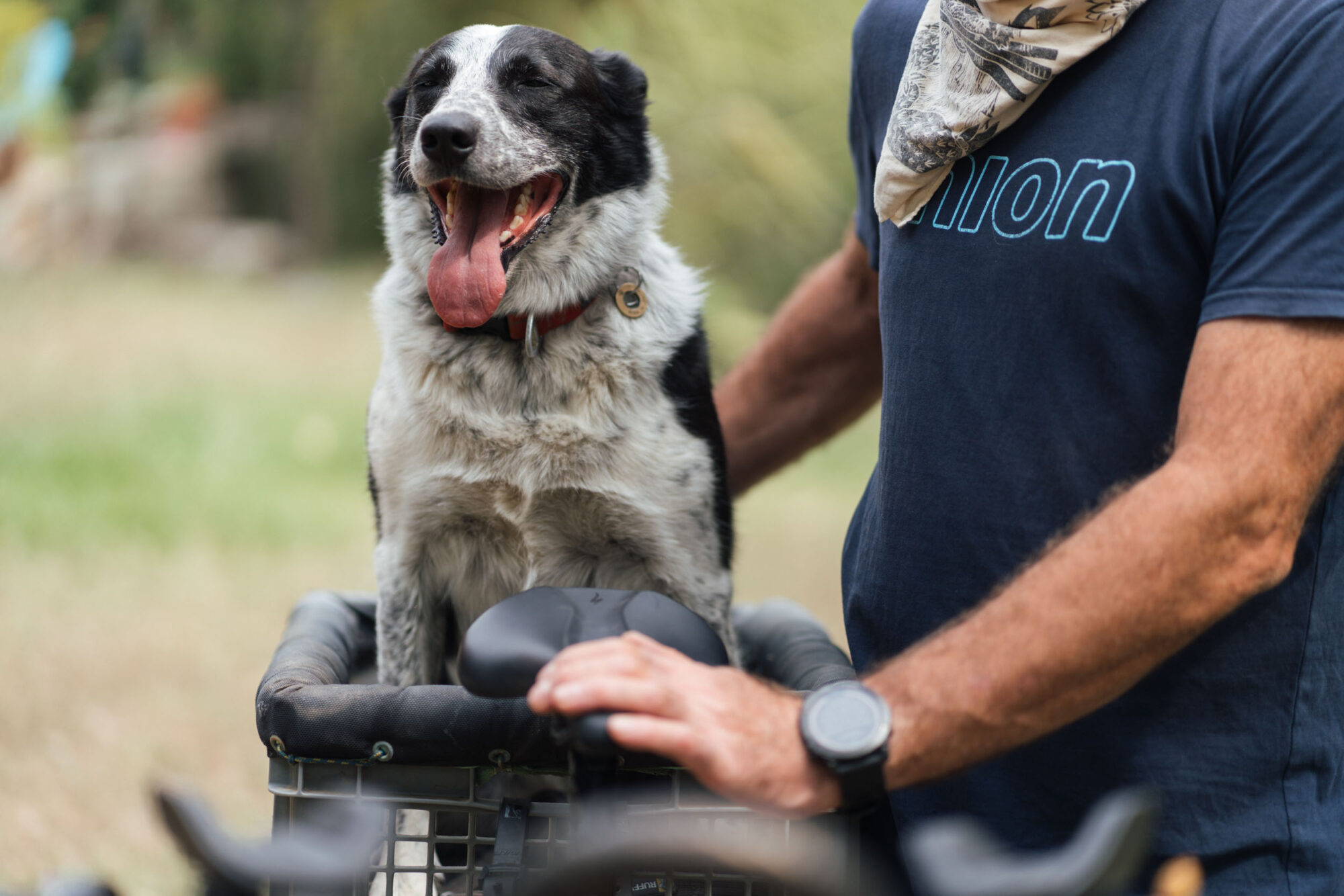
Anyone you’d like to thank for gear support?
We have some amazing companies supporting our adventure. Many of the great products that you see us use have been supplied by amazing people that work at these companies. They include Mountain Exposure, Maxxis Tires, IceBreaker, 5’10 MTB shoes, Pinion.eu, Gates Carbon drive belts, Astral Cycling (wheels), Swiss Stop (pads & rotors), Wren Sports (suspension fork, Perseverance Adventure Bar), Grey Goose Mobile Veterinary (consulting veterinarian). And our terrific Patreon community.
To follow along with John and Mira’s world tour, tune into their Instagram feed and subscribe to their Youtube channel. Consider supporting them via Patreon or by buying some of their Mira merch. I have their bandana, and love it! And be sure to check out how they’re doing doing on the Tour Divide race via our Tracker, which is happening now.
Further Reading
Make sure to dig into these related articles for more info...
Please keep the conversation civil, constructive, and inclusive, or your comment will be removed.













